Vol. 72, No. 16 (2023)
2023-08-20
GENERAL
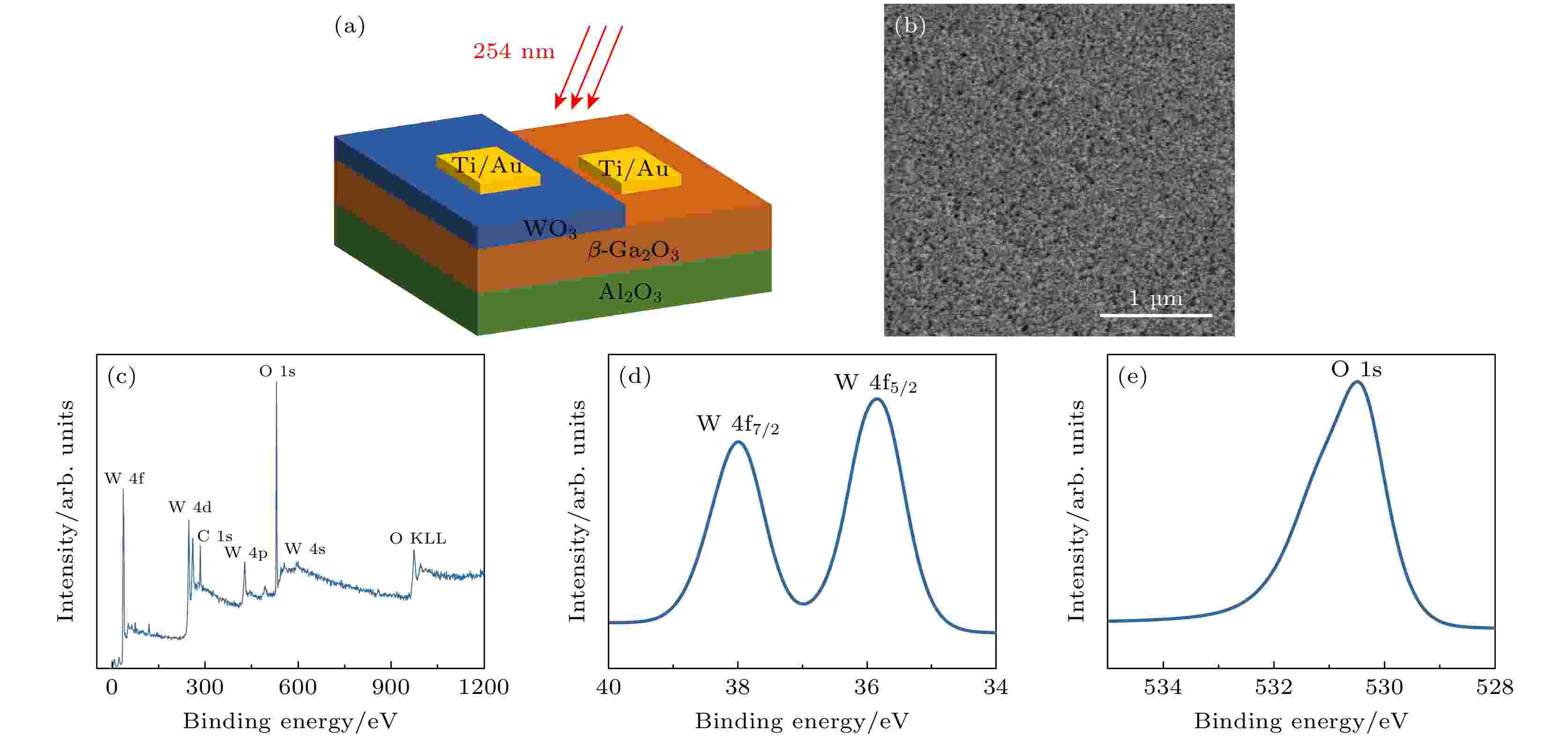
EDITOR'S SUGGESTION
2023, 72 (16): 160201.
doi:10.7498/aps.72.20230638
Abstract +
Owing to the high bandgap of up to 4.8 eV, Ga2O3has a natural advantage in the field of deep-ultraviolet (DUV) detection. The Ga2O3-based photoconductors, Schottky and heterojunction detectors are proposed and show excellent photodetection performance. The Ga2O3heterojunction detectors are self-driven and feature low power consumption. On the other hand, considering the ultra-wide bandgap and low intrinsic carrier concentration, Ga2O3-based photodetectors are exhibiting important applications in high-temperature photodetection. In this work, a WO3/β-Ga2O3heterojunction DUV photodetector is constructed and the effect of high temperature on its detection performance is investigated. Theβ-Ga2O3films are prepared by metal-organic chemical vapor deposition (MOCVD), and WO3films and Ti/Au ohmic electrodes are prepared by spin-coating technology and magnetron sputtering technique, respectively. The current-voltage (I-V) and current-time (I-t) measurements are performed at different ambient temperatures. Parameters including light-dark-current ratio (PDCR), responsivity (R), detectivity (D*), and external quantum efficiency (EQE) are extracted to evaluate the deep-ultraviolet detection performance and its high-temperature stability. At room temperature (300 K), the PDCR, theR, theD*, and the EQE of the detector are 3.05×106, 2.7 mA/W, 1.51×1013Jones, and 1.32%, respectively. As the temperature increases, the dark current of the device increases and the photocurrent decreases, resulting in the degradation of the photodetection performance. To explore the physical mechanism behind the degradation of the detection performance, the effect of temperature on the carrier generation-combination process is investigated. It is found that the Shockley-Read-Hall (SRH) generation-combination mechanism is enhanced with the increase of temperature. Recombination centers are introduced from the crystal defects and interfacial defects, which originate mainly from the SRH process. Specifically, the dark current comes mainly from the depletion region of WO3/β-Ga2O3, and the carrier generation rate in the depletion region is enhanced with temperature increasing, which leads to the rise of dark current. Similarly, the increase of temperature leads to the improvement of the recombination process, therefore the photocurrent decreases at a higher temperature. This effect can also well explain the variation of response time at a high temperature. Overall, it is exhibited that the WO3/β-Ga2O3heterojunction photodetector can achieve stable self-powered operation even at an ambient temperature of 450 K, indicating that the all-oxide heterojunction detector has potential applications in harsh detection environments.

2023, 72 (16): 160301.
doi:10.7498/aps.72.20230398
Abstract +
With the rapid development of radio frequency technology such as radar, electronic warfare and 5G communication, the measurement and real-time spectrum characterization of broadband radio frequency signals become increasingly important. The traditional radio frequency signal real-time measurement technology is limited by the sampling rate of analog-to-digital converter and the ability to process digital signals, and encounters the problems of narrow measurement band, large data volume, and susceptibility to electromagnetic interference. This work is to study a radio frequency signal measurement technology based on quantum compression sensing, which uses integrated electro-optical crystal as radio frequency sensor, and constructs a compression sensing machine by modulating the photon wave function of the measured radio frequency signal to realize the compression measurement of broadband radio frequency signal, significantly improving the spectrum sensing bandwidth. The experiment demonstrates the long-term spectrum monitoring of power frequency and intermediate frequency high voltage signals, and the real-time spectrum measurement of high frequency radio frequency signals. Under the Fourier limit spectrum resolution, the real-time spectrum analysis bandwidth of GHz magnitude is realized, and the data compression rate reaches 1.7×10–5, which can meet the needs of 5G wireless communication, cognitive radio and other applications for broadband radio frequency signal spectrum measurement, and provide a new technical path for developing the next-generation broadband spectrum sensing technology.
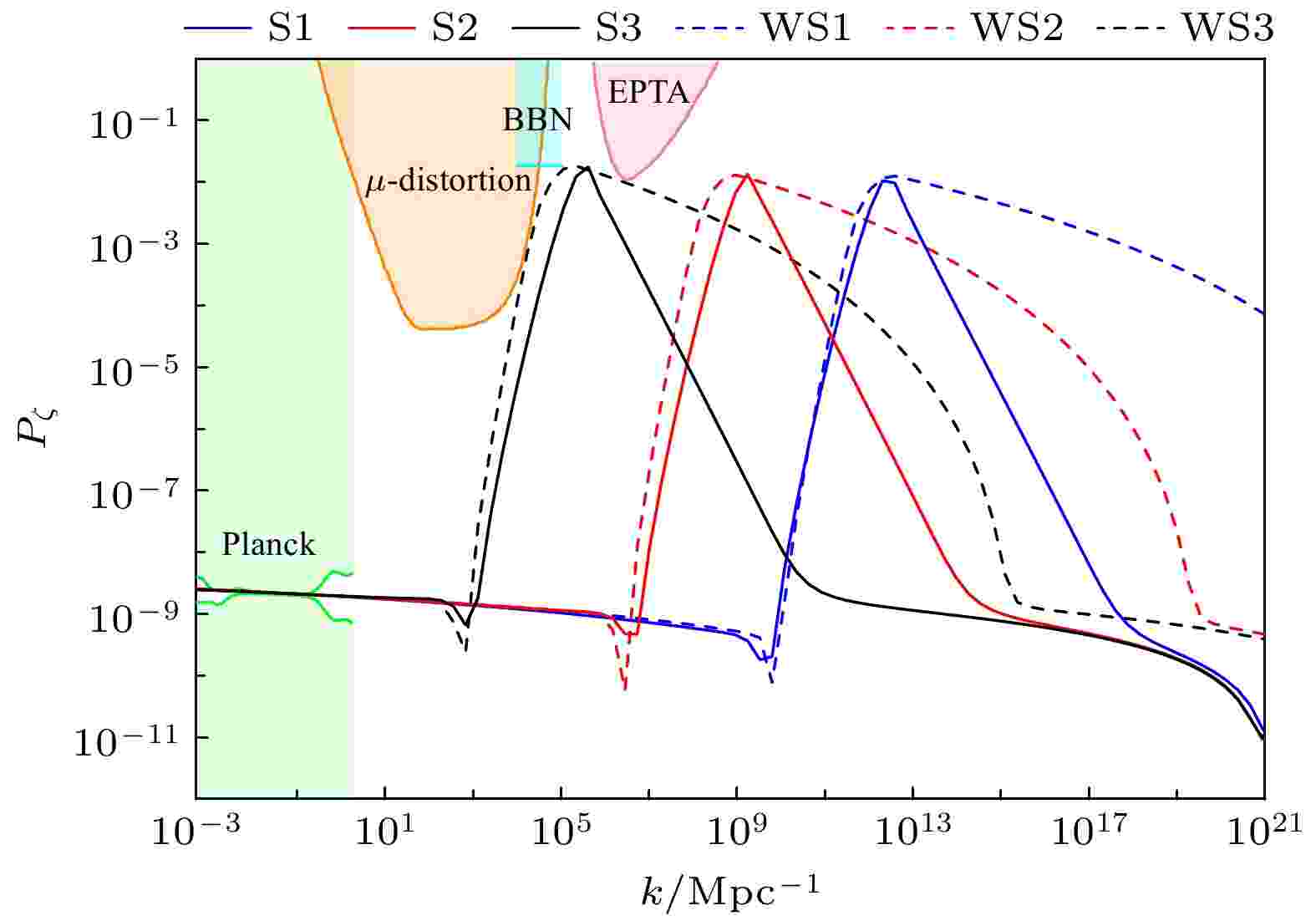
EDITOR'S SUGGESTION
2023, 72 (16): 160401.
doi:10.7498/aps.72.20230605
Abstract +

2023, 72 (16): 160501.
doi:10.7498/aps.72.20230338
Abstract +
In quantum mechanics, the Hermitian Hamiltonian is generally used to describe the ideal closed quantum system, but in reality, the physical system is closely related to the environment, and the open quantum system coupled to the environment can be described by the equivalent non-Hermitian Hamiltonian to a certain extent. Among them, the dissipation intensity is closely related to the dynamic properties of non-Hermitian quantum systems. Therefore, it is of great practical significance to study how dissipation affects particle loss. In this paper, the dynamic law related to dissipation intensity in a one-dimensional non-Hermitian system under open boundary condition is studied, and it is found that dissipation can induce the recurrence of edge burst. After the time-dependent evolution of the particles in the one-dimensional non-Hermitian dissipative lattice system with open boundary condition, there is an edge burst in the system, that is, there is a large probability of particle loss at the edge, and the edge burst disappears after increasing the intracell hopping. It is found that if the dissipation intensity increases or decreases, the edge burst will reappear. This kind of reappearance is different from the original edge burst, which is mainly manifested in the loss probability distribution of particles from the edge distribution to the bulk distribution, which is due to the difference in probability of particle motion direction between the two cases. Under the re-induced edge burst, the particles move leftward and rightward from their initial positions, and rebound from the left after having reached the boundary, forming a more obvious loss probability at the edge and gradually decreasing to the body area. In the original edge burst, the particles only move to the left with a greater probability, and are ‘trapped’ at the edge to completely dissipated, forming a distribution with an independent loss peak at the edge. The movement to the left is due to the non-Hermitian skin effect. The deeper reason for different movement directions is related to parity-time symmetry. Under the parameter near the parity-time symmetry breaking point, the loss probability of the particle is of unilateral distribution, and the loss probability of the particle moving to both sides is of bilateral distribution when it is far away. This is the description of the dissipation-induced edge burst recurrence phenomenon and its characteristics. In addition, this paper also studies the influence of impurity barrier on the probability distribution of particle loss in non-Hermitian dynamics. The results show that placing a small barrier on the non-dissipativeA-site can obviously hinder the particle motion, and when the barrier increases to a certain height, its influence on the particle motion tends to be unchanged. And the barrier at the dissipativeBlattice has little effect on the dynamics.
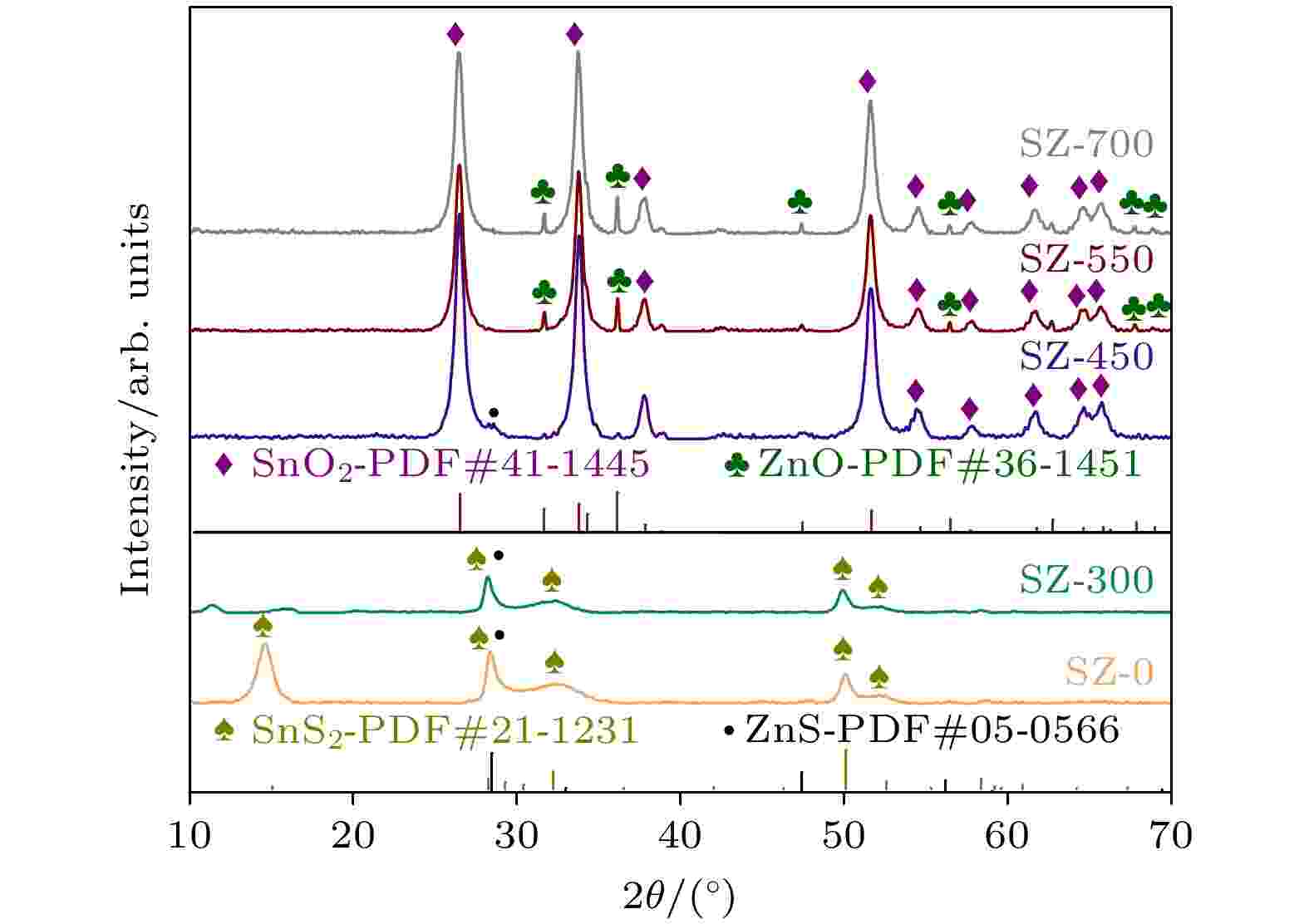
2023, 72 (16): 160701.
doi:10.7498/aps.72.20230735
Abstract +
SnS2/ZnS microflower structures are prepared by one-step hydrothermal method. The microflower structures with different components are obtained after calcinating SnS2/ZnS in air atmosphere. The influences of calcination temperature on the components and gas-sensing properties of microflower structures are investigated by X-ray diffractometry (XRD), scanning electron microscopy (SEM), X-ray energy dispersive spectroscopy (EDS), transmission electron microscopey (TEM), and gas sensitive characteristic analyzer. The results show that the gas-sensing performance to NO2at room temperature of SnO2/ZnS microflower structure (SZ-450) is better than that of microflower structure calcinated at the other temperature. The response of SZ-450-based sensor to 10–4NO2at room temperature can reach 27.55, the response/recovery time is 53 s/79 s, the theoretical detection limit is as low as 2.1×10–7, and it has good selectivity, repeatability, and stability. The analysis indicates that the excellent room-temperature gas-sensing characteristic of SZ-450 is related to the heterojunction between SnO2and ZnS. This work can provide sensitive materials for room-temperature NO2gas sensor and promote its development and application.
COVER ARTICLE

COVER ARTICLE
2023, 72 (16): 160302.
doi:10.7498/aps.72.20230740
Abstract +
Topological pumping enables the quantized transport of matter waves through an adiabatic evolution of the system, which plays an essential role in the applications of transferring quantum states and exploring the topological properties in higher-dimensional quantum systems. Recently, exploring the interplay between novel topological pumping and interactions has attracted growing attention in topological systems, such as nonlinear topological pumping induced by interactions. So far, the experimental realizations of the nonlinear topological pumps have been realized only in the optical waveguide systems with Kerr nonlinearity. It is still necessary to further explore the phenomenon in different systems. Here, we present an experimental proposal for realizing the nonlinear topological pumping via a one-dimensional (1D) off-diagonal Aubry-André-Harper (AAH) model with mean-field interactions in the momentum space lattice of ultracold atoms. In particular, we develop a numerical method for calculating the energy band of the nonlinear systems. With numerical calculations, we first solve the nonlinear energy band structure and soliton solution of the 1D nonlinear off-diagonal AAH model in the region of weak interaction strengths. The result shows that the lowest or the highest energy band is modulated in the nonlinear system of
$ g > 0$
or
$ g < 0$
, respectively. The eigenstates of the associated energy bands have the features of the soliton solutions. We then show that the topological pumping of solitons exhibits quantized transport characteristics. Moreover, we numerically calculate the Chern number associated with the lowest and highest energy bands at different interaction strengths. The result shows that the quantized transport of solitons is determined by the Chern number of the associated energy band of the system from which solitons emanate. Finally, we propose a nonlinear topological pumping scheme based on a momentum lattice experimental system with
$ ^{7}\text{Li}$
atoms. We can prepare the initial state, which is approximately the distribution of the soliton state of the lowest energy band, and calculate the dynamical evolution of this initial state in the case of
$ U > 0$
. Also, we analyze the influence of adiabatic evolution conditions on the pumping process, demonstrating the feasibility of nonlinear topological pumping in the momentum lattice system. Our study provides a feasible route for investigating nonlinear topological pumping in ultracold atom systems, which is helpful for further exploring the topological transport in nonlinear systems, such as topological phase transitions and edge effects induced by nonlinearity.
NUCLEAR PHYSICS
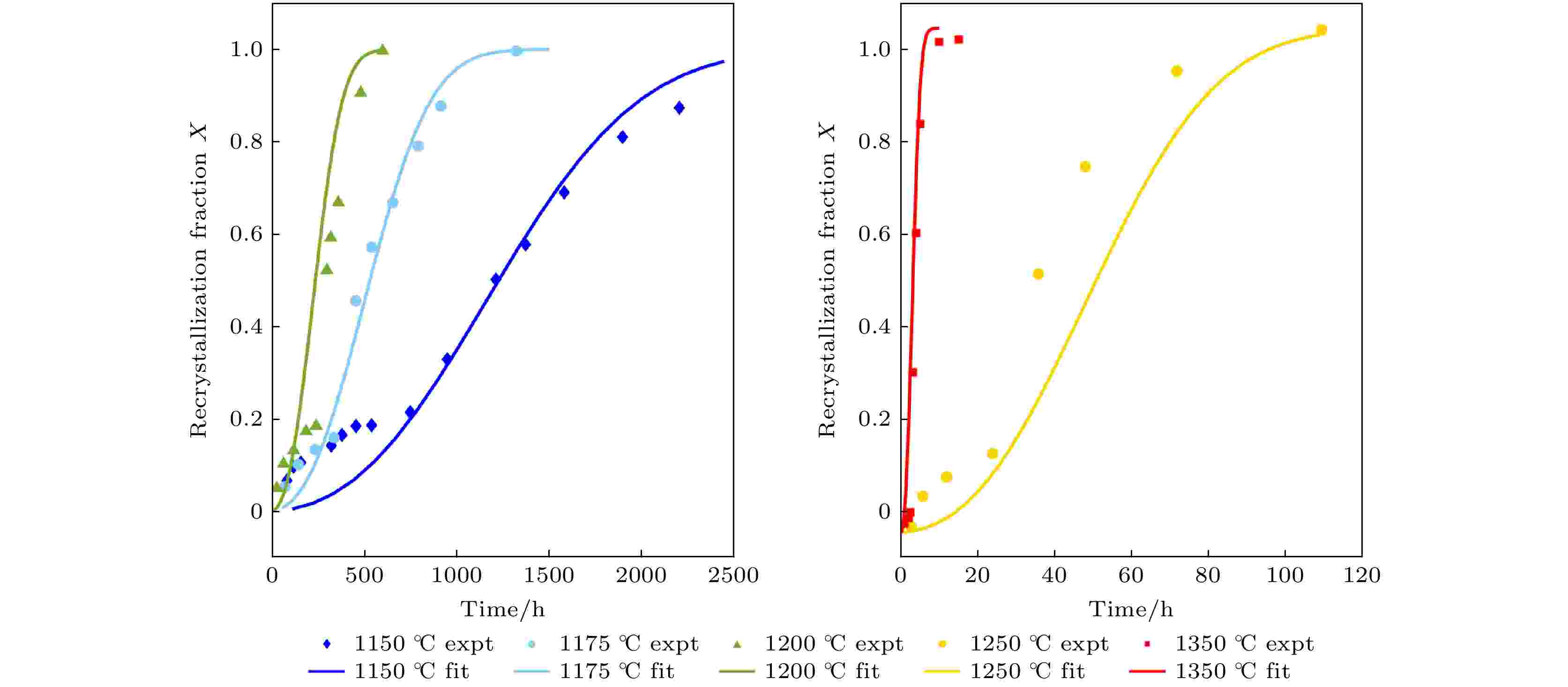
EDITOR'S SUGGESTION
2023, 72 (16): 162801.
doi:10.7498/aps.72.20230531
Abstract +
ATOMIC AND MOLECULAR PHYSICS
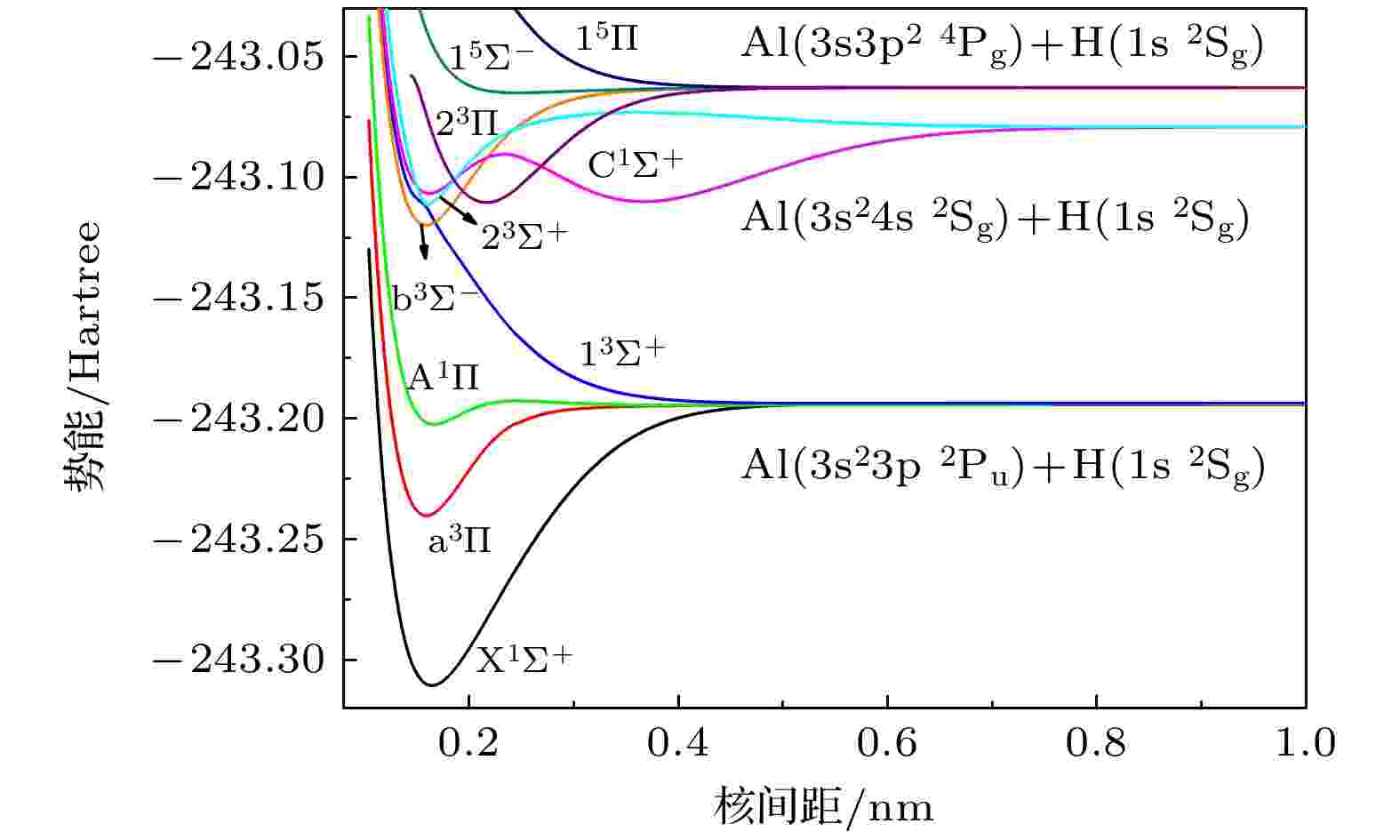
2023, 72 (16): 163101.
doi:10.7498/aps.72.20230615
Abstract +
On the basis of correcting various errors caused by spin-orbit coupling effects, scalar relativity effects, core-valence correlation effects and basis set truncation, the potential energy curves of 10 Λ-S states and 26 Ω states of AlH molecule are calculated by using icMRCI +Qmethod. The transition dipole moments of 6 pairs of transitions between the
${\rm X}{}^1\Sigma _{{0^ + }}^ + $
,
$ {\rm a^3}{\Pi _{{0^ + }}} $
,
${\rm a^3}{\Pi _1} $
,
${\rm a^3}{\Pi _2} $
, and
${\rm A^1}{\Pi _1} $
states are calculated by using the icMRCI/AV6Z* theory with the consideration of spin-orbit coupling effects. The spectral and transition data obtained here for AlH molecule are in very good agreement with the available experimental measurements. The findings are below. 1) The transition intensities are relatively strong of the Q(J″) branches for the (0, 0), (0, 1), (0, 2), (1, 0), (1, 1), (1, 2), (1, 3), (1, 4) and (1, 5) bands of the A1Π1–
${\rm X}{}^1\Sigma _{{0^ + }}^ + $
transition, with the increase ofJ″; the EinsteinAcoefficients and vibrational branching ratio gradually decrease, and the weighted absorption oscillator strength gradually increases of Δυ= 0 band, the EinsteinAcoefficient, vibrational branching ratio, and weighted absorption oscillator strength gradually increase for the Δυ≠ 0 bands. 2) The radiation lifetimes of A1Π1(υ'= 0, 1) increases slowly as theJ'increases. 3) The A1Π1(υ'= 0 and 1,J'= 1, +) →
${\rm X}{}^1\Sigma _{{0^ + }}^ + $
(υ''= 0–3,J'′ = 1, –) transition of AlH molecule satisfies the criteria for laser cooling of diatomic molecules, that is, the vibrational branching ratio of the highly diagonal distribution, the extremely short radiation lifetimes of the A1Π1(υ'= 0 and 1,J'= 1, +) states, and the intermediate electronic states
$ {\rm a^3}{\Pi _{{0^ + }}} $
, a3Π1, and a3Π2do not interfere with laser cooling. Therefore, based on the cyclic transition A1Π1(υ'= 0 and 1,J'= 1, +) ↔
${\rm X}{}^1\Sigma _{{0^ + }}^ + $
(υ'′ = 0–3,J''= 1, –), we propose a feasible scheme for laser cooling of AlH molecule. When cooled, 2.541 × 104photons can be scattered by four pump lasers used in the visible range, which are enough to cool AlH to the ultra-cold temperature, and the Doppler temperature and recoil temperature of the main transition are on the order of μK.
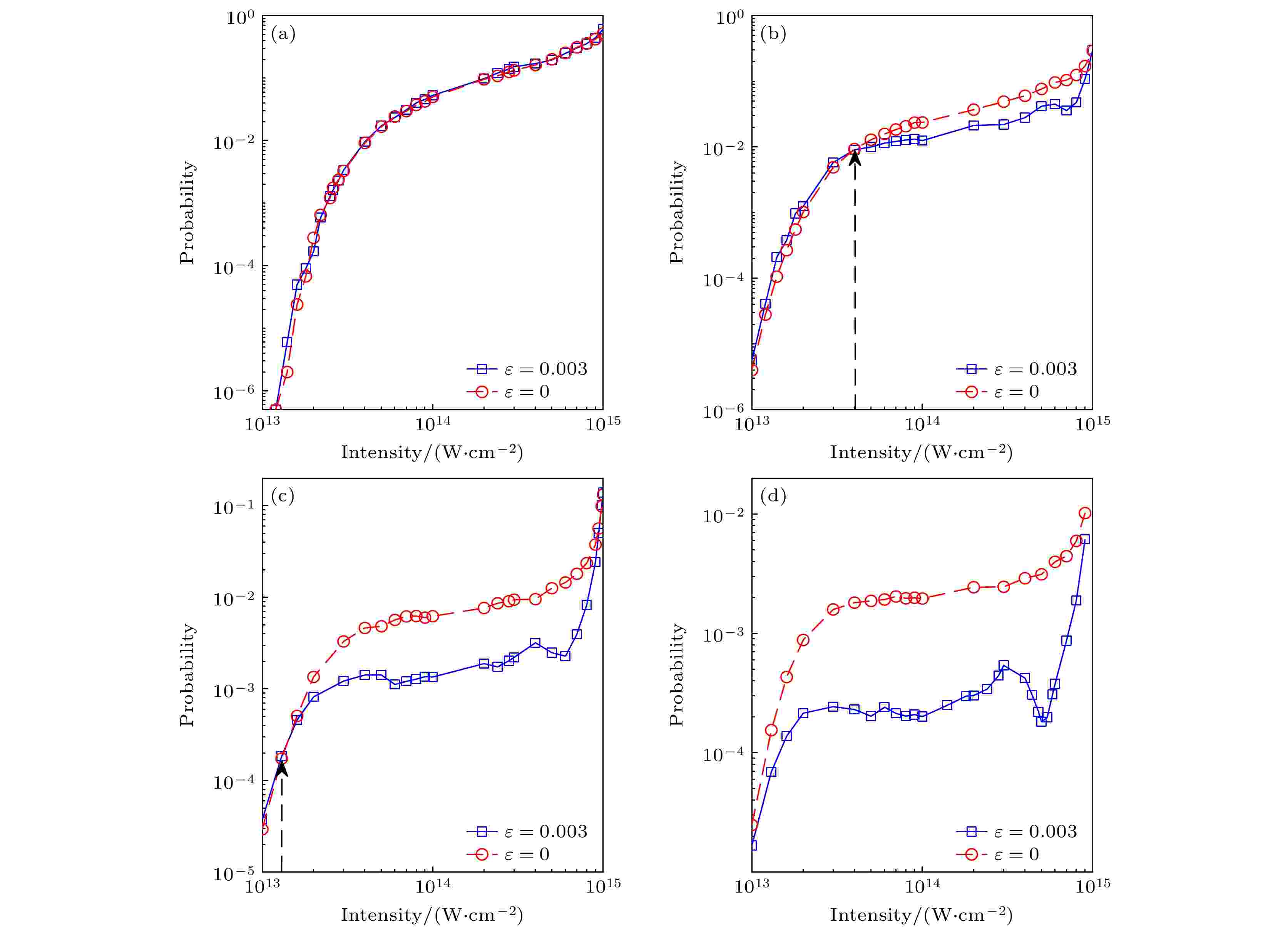
2023, 72 (16): 163201.
doi:10.7498/aps.72.20230548
Abstract +
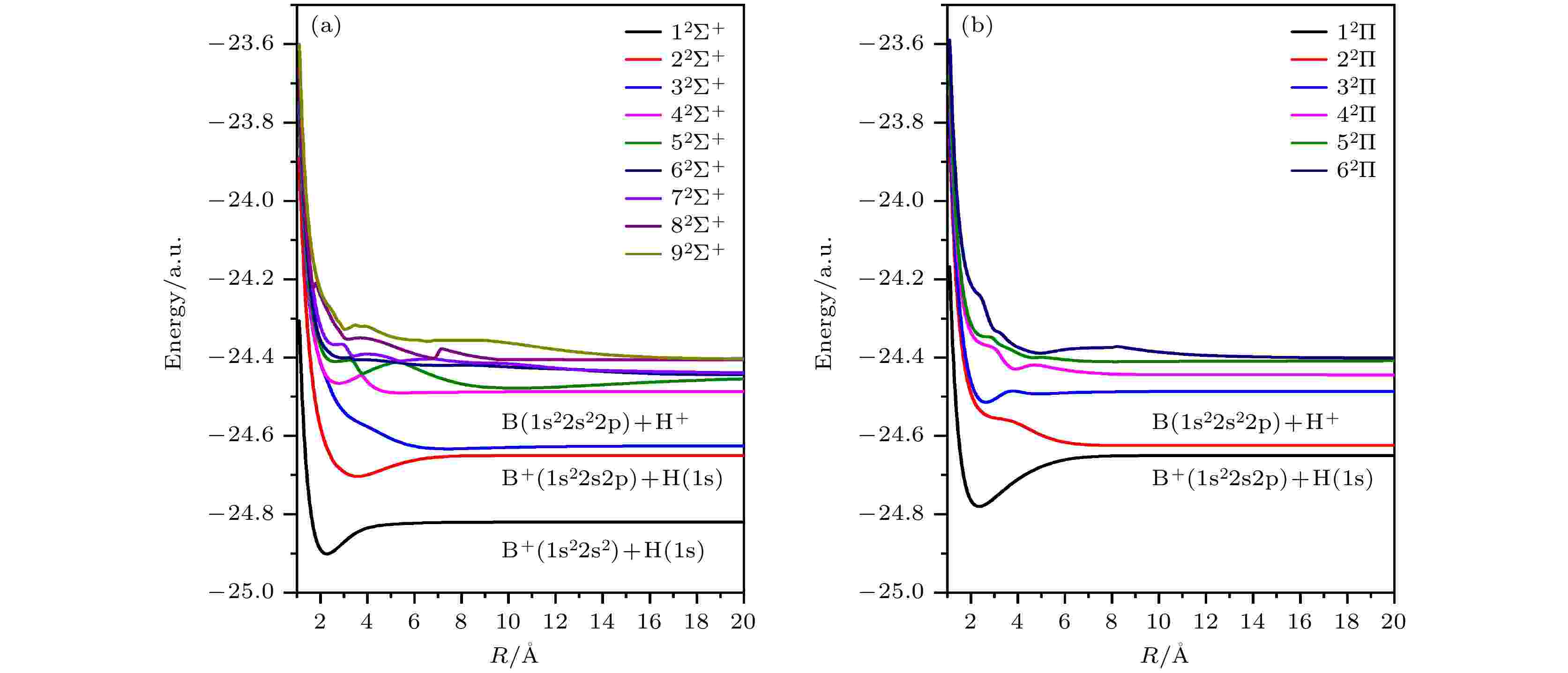
EDITOR'S SUGGESTION
2023, 72 (16): 163401.
doi:10.7498/aps.72.20230470
Abstract +
Electron transfer in heavy particle collisions, involving complicated electron correlation mechanisms, greatly affects the charge state balance in plasma, and is also one of important sources for X-ray radiation. Electron transfer cross section and rate coefficient are important atomic parameters required for the development of nuclear fusion plasma in the national defense industry. We systematically investigate the electron transfer process of proton impacting boron atom in an energy range of
${10}^{-3}-{10}^{3}\;{\rm{e}}{\rm{V}}/{\rm{u}}$
based on a fully quantum non-radiative molecular orbital close-coupling method. A total of 15 channels of electron transfer, excitation, and elastic scattering are obtained by using the multi-reference configuration interaction method, and the corresponding molecular energy of each channel is in good agreement with the experimental results. The phenomenon of avoiding crossing between the adiabatic potential energy curves of molecular states is obvious, which constituents the main pathway of electron transfer. The calculation shows that the electron transfer of the 2s orbital is dominated in the process of proton impacting boron atom, while the electron transfer of the 2p orbital contributes a little. In the low energy region, there are obvious quantum resonances in the electron transfer cross section, which originate from the coupling between high energy channel and low energy channel. In addition, we calculate the electron transfer rates of proton-impact boron atom at different temperatures, which can provide important atomic parameter which support for simulating and diagnosing complex plasma environments.
ELECTROMAGNETISM, OPTICS, ACOUSTICS, HEAT TRANSFER, CLASSICAL MECHANICS, AND FLUID DYNAMICS
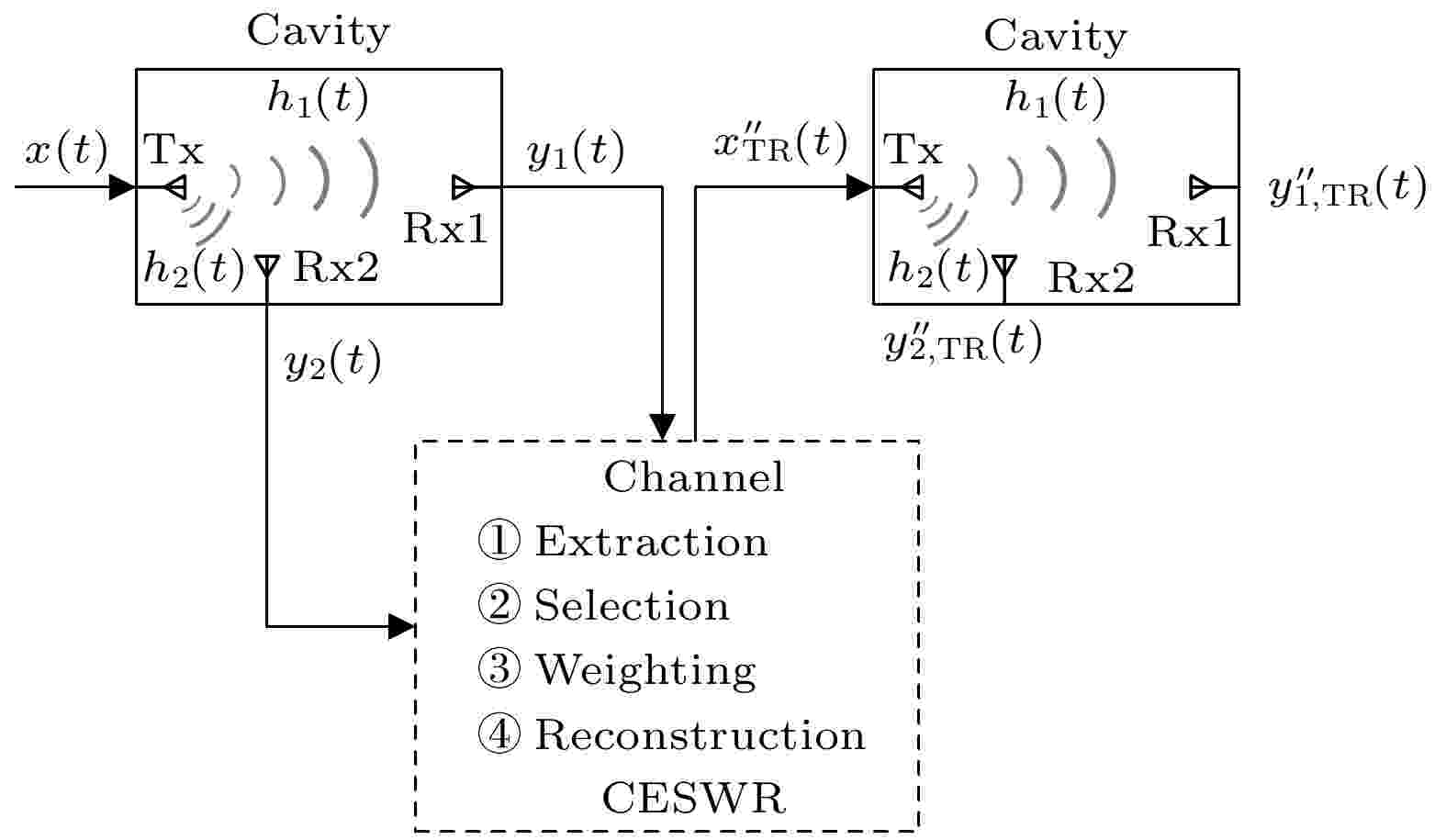
2023, 72 (16): 164101.
doi:10.7498/aps.72.20230547
Abstract +
Achieving tunable focus of electromagnetic field energy at multiple target points is a critical challenge in the wireless power transfer (WPT) domain. In order to solve this problem, some techniques such as optimal constrained power focusing (OCPF) and time reversal (TR) have been proposed. The former presents limited practical applicability while the latter is noteworthy for its adaptive spatiotemporal synchronous focusing characteristics. However, the time reversal mirror (TRM) method necessitates intricate pretesting and has highly complex systems. In this study, we introduce a novel channel processing method, named channel extraction, selection, weighting, and reconstruction (CESWR), to attain balanced power distribution for multiple users, featuring low complexity, high computability, and rapid convergence. Unlike the traditional TR approach, our proposed method, based on channel correlation considerations, filters the channel impulse response (CIR) for multiple targets, dividing them into distinct characteristic and similar components for each target. This method ensures focused generation at both receiving ends while facilitating high-precision regulation of the peak voltage of the received signal. Furthermore, this study implements a rigorous examination of the linearity intrinsic to the proposed method, explicating a singular correspondence between the tuning of theoretical weights and the resultant outcomes. In order to verify the efficacy of this method, we construct a single-input multiple-output time-reversal cavity (SIMO-TRC) system. Subsequent experiments conducted for both loosely and tightly correlated models, provide invaluable insights. Evidently, in the loosely correlated model, the CESWR method exhibits proficiency in attaining a peak voltage ratio (PVR) of nearly 1.00 at the two receivers, with a minuscule numerical discrepancy of merely
$8 \times {10^{ - 6}}$
mV. In stark contrast, under the tightly correlated model, the CESWR method demonstrates an enhanced ability to differentiate between two targets, thus offering a noticeable improvement over the classic single-target TR method.
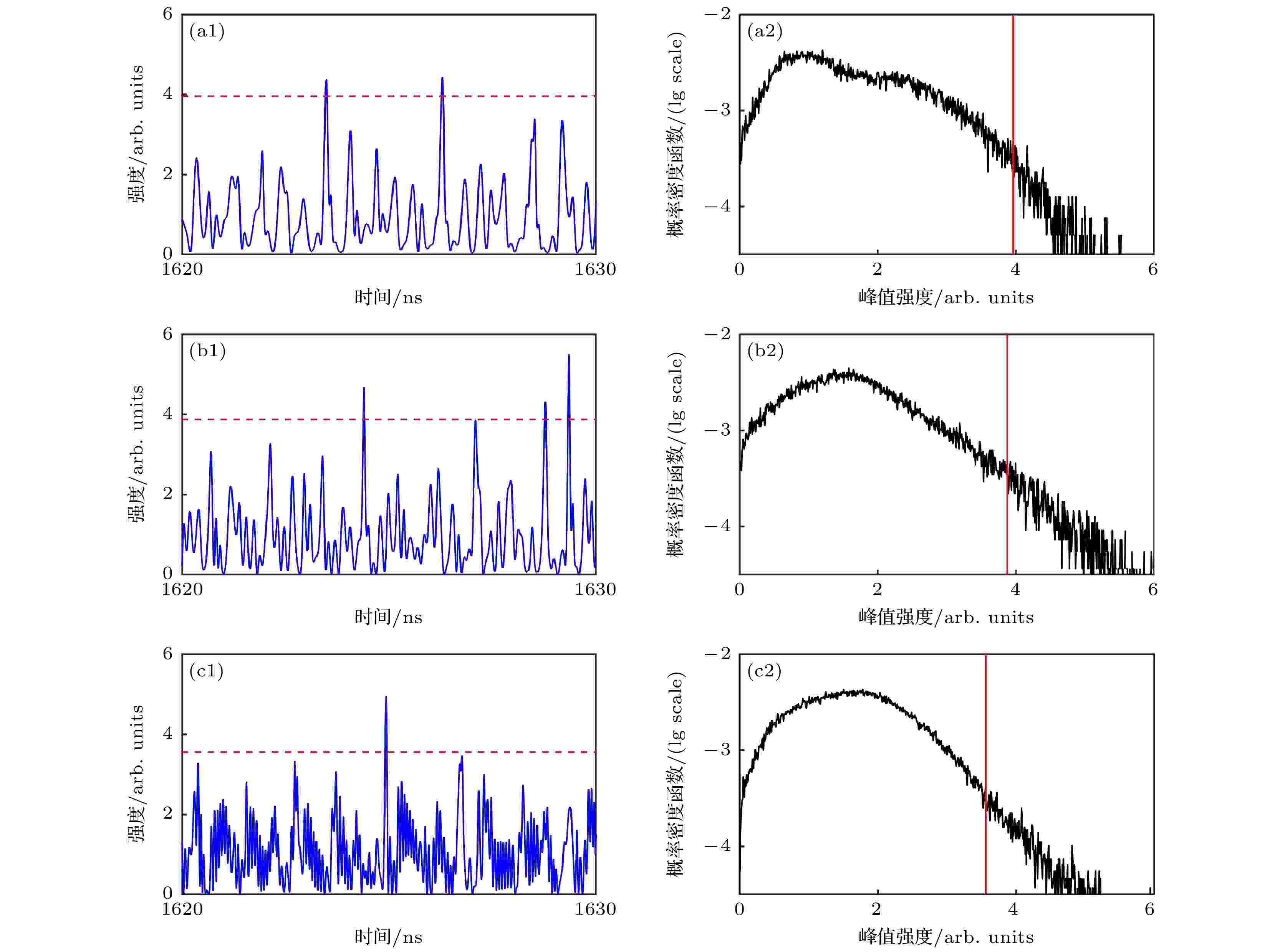
EDITOR'S SUGGESTION
2023, 72 (16): 164201.
doi:10.7498/aps.72.20230759
Abstract +
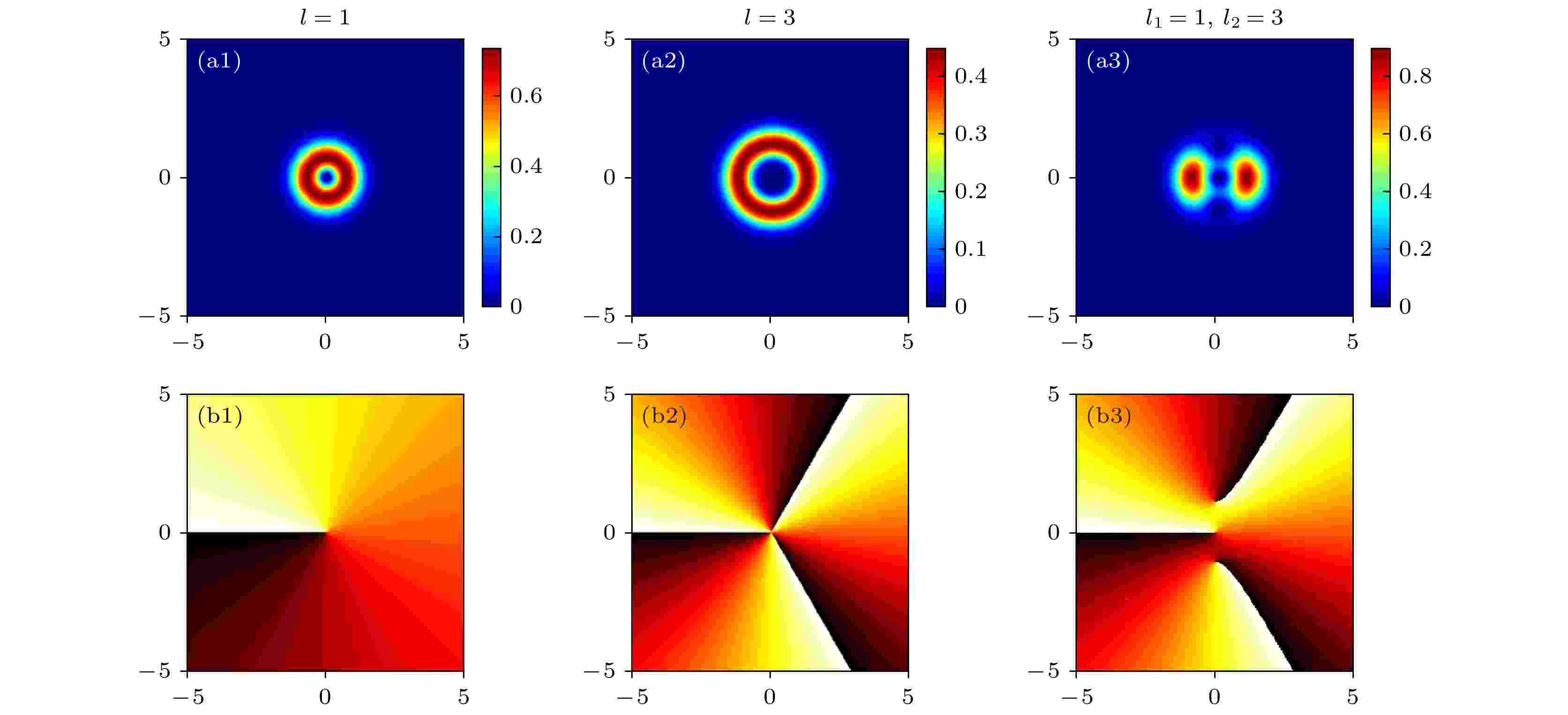
2023, 72 (16): 164202.
doi:10.7498/aps.72.20230684
Abstract +
The effects of thermal blooming on orbital angular momentum (OAM) and phase singularity of dual-mode vortex beams under different wind directions and wind speeds are studied in this paper. Owing to the different symmetries of dual-mode vortex beams superimposed by different modes, the effects of thermal blooming on them depend on not only wind speed, but also wind direction. Based on the scalar wave equation and the hydrodynamic equation, a four-dimensional (4D) computer code to simulate the time-dependent propagation of dual-mode vortex beams in the atmosphere is devised by using the multiphase screen method and finite difference method. It is found that for a certain wind direction, the value of OAM increases with the wind speed decreasing because the thermal blooming becomes more serious, i.e. the thermal blooming effect promotes the OAM of dual-mode vortex beam to grow. For example, when the angle between the wind direction and the beam is 0 <θ< 50°, the OAM of the dual-mode vortex beams with a topological charge difference of 2 increases with wind speed decreasing, and there is an optimal angle (
$ \theta \approx {20^ \circ } $
) to maximize OAM. Therefore, for a certain wind direction and wind speed, the OAM of dual-mode vortex beam propagating in the atmosphere can be larger than that in free space, and can be larger than the OAM of single-mode vortex beam. The dual-mode vortex beam with higher modes requires smaller wind speed to make its OAM larger than the OAM in free space. In addition, the larger the difference in topological charge between the two element beams of a dual-mode vortex beam, the more stable the OAM of the dual-mode vortex beam is. On the other hand, the evolution of linear edge dislocation singularity under atmospheric thermal blooming is also investigated in this paper. When the wind direction is perpendicular to the dislocation line, the linear edge dislocation singularity disappears. If the wind direction is parallel to the dislocation line, the linear edge dislocation singularity always exists. At other angles, the linear edge dislocation singularity will evolve into optical vortex pairs. The results obtained in this paper have a certain reference value for the propagation of lasers in the atmosphere and optical communication.

2023, 72 (16): 164203.
doi:10.7498/aps.72.20230673
Abstract +
Facing the increasing capacity requirements of on-chip optical interconnects, mode division multiplexing technology (MDM), which fully uses the different spatial eigenmodes at the same wavelength as independent channels to transmit optical signals, has attracted tremendous interest. Mode-order converter that can convert the fundamental mode into high-order mode is a key component in MDM system. However, it is still very challenging to achieve compact mode-order converters with high performances. Subwavelength grating (SWG) can be equivalent to homogenous material, which has the prominent advantages such as controlling over birefringence, dispersion and anisotropy, thus making photonic devices possess high performance. Wheras the conventional SWG only needs single-etch step, but the implementation of SWG structure usually requires a fabrication resolution on the order of 100 nm and below, which is difficult for current wafer-scale fabrication technology. The anisotropic response of SWG can be further engineered by introducing bricked topology structure, providing an additional degree of freedom in the design. Meanwhile, the requirement for fabrication resolution can also be reduced (> 100 nm). In this work, we experimentally demonstrate compact TE0-TE1mode-order converter and TE0-TE2mode-order converter by using a bricked subwavelength grating (BSWG) based on a silicon-on-insulator (SOI) with the BSWG having a minimum feature size of 145 nm. In the proposed mode-order converter, a quasi-TE0mode is generated in the BSWG region, which can be regarded as an effective bridge between the two TE modes to be converted. Flexible mode conversion can be realized by only choosing appropriate structural parameters for specific mode transitions between input/output modes and the quasi-TE0mode. By combining three-dimensional (3D) finite difference time domain (FDTD) and particle swarm optimization (PSO) method, TE0-TE1mode-order converter and TE0-TE2mode-order converter are optimally designed. They can convert TE0mode into TE1and TE2mode with conversion length of 9.39 µm and 11.27 µm, respectively. The simulation results show that the insertion loss of < 1 dB and crosstalk of < –15 dB are achieved for both TE0-TE1mode-order converter and TE0-TE2mode-order converter, their corresponding working bandwidths being 128 nm (1511–1639 nm) and 126 nm (1527–1653 nm), respectively. The measurement results indicate that insertion loss and crosstalk are, respectively, less than 2.5 dB and –10 dB in a bandwidth of 68 nm (1512–1580 nm, limited by the laser tuning range and grating coupler).
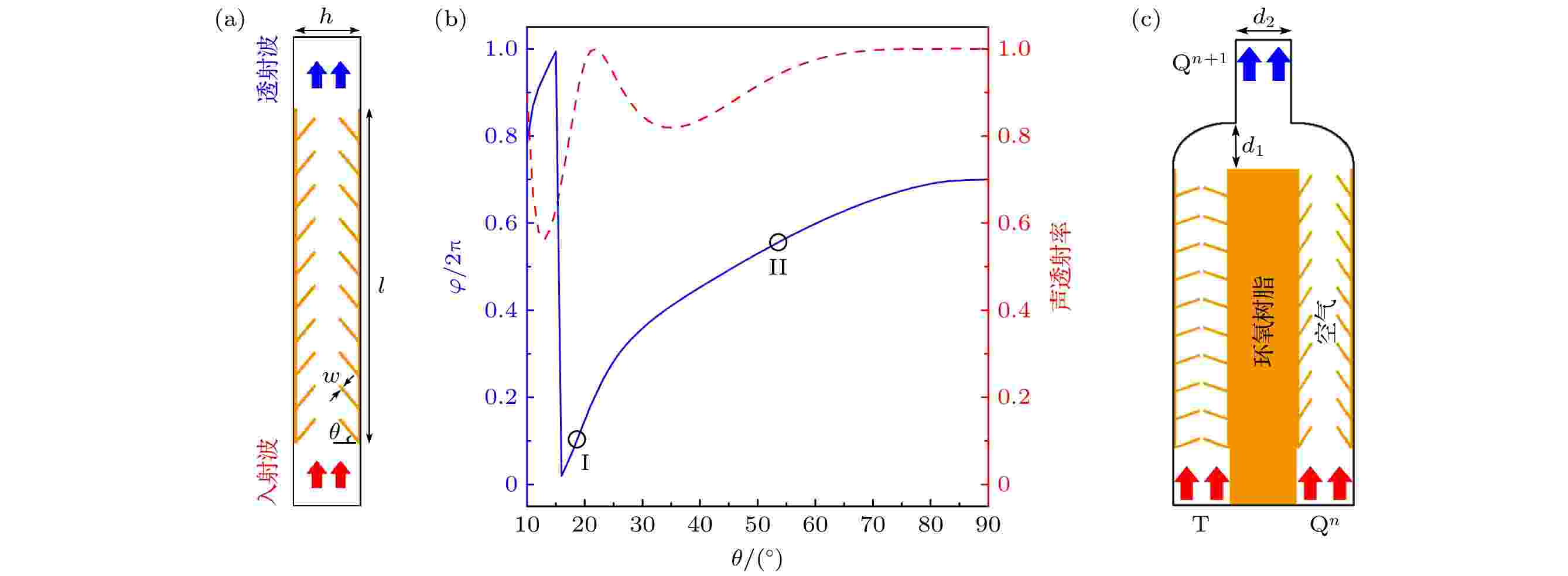
2023, 72 (16): 164301.
doi:10.7498/aps.72.20230594
Abstract +
The study of acoustic information processing has attracted great attention owing to its advantages of anti-electromagnetic interference and low energy consumption. Acoustic logic device, as a fundamental component, plays an important role in designing integrated acoustic systems. In the past few years, with the rapid development of sonic crystals, acoustic metamaterials and metasurfaces, researchers have demonstrated a variety of acoustic logic gates based on different mechanisms, and have devoted their efforts to the promotion of the practical applications. The more complex acoustic triggers with broad bandwidth and subwavelength size are very important for developing integrated sound devices, but it is difficult to realize them. In this work, we design two types of acoustic triggers based on the mechanisms of linear interference and phase modulation. The acoustic trigger with a width of 0.32λand length of 0.82λis composed of phased unit cells and multi-port waveguide structures, showing a subwavelength structure. Based on the phase modulation of the phased unit cells and the mechanism of linear interferences, the acoustic T-type trigger and D-type trigger with the same threshold are designed and demonstrated experimentally. The corresponding working bands of the T-type and D-type triggers are 3.293–4.069 kHz and 3.400–4.138 kHz, and their fractional bandwidths (the ratio of the bandwidth to the center frequency) can reach about 0.23 and 0.22, respectively, showing a broadband characteristic of both triggers. The mechanism of the T-type trigger is attributed to the linear interference caused by two phased unit cells with a phase difference of π. However, the realization of the D-type trigger is closely related to the incident sound energy and the phase modulation caused by the phased unit cell in the control port. The measured results and simulated results agree well with each other. Compared with other types of acoustic logic devices, the designed acoustic triggers have the advantages of broad bandwidth, subwavelength size, same threshold, and passive structure, as well as being easy to integrate, thus providing great potential applications in acoustic computing, acoustic communication, acoustic information processing and integrated acoustics. Our experimental demonstration of acoustic triggers can further promote the theoretical and experimental investigations of basic acoustic components.
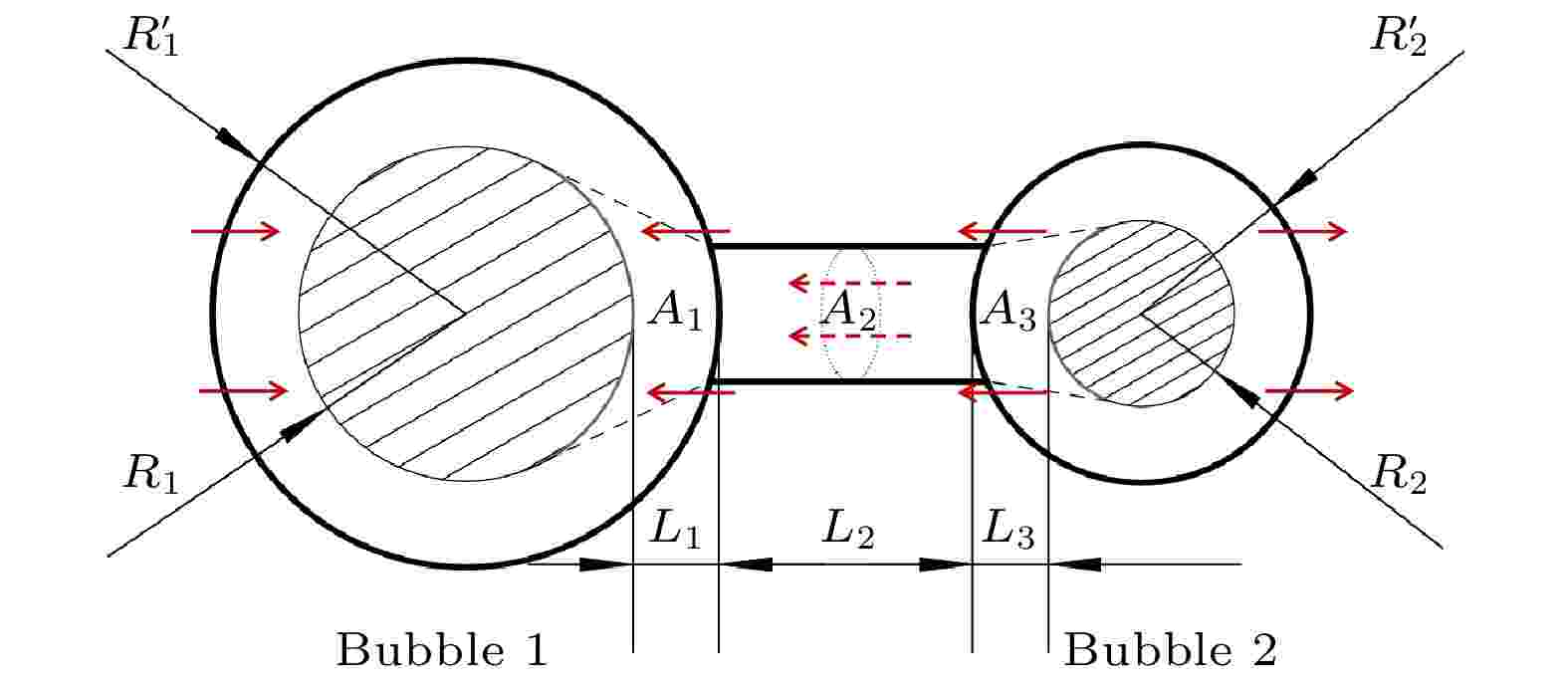
2023, 72 (16): 164701.
doi:10.7498/aps.72.20230695
Abstract +
Ostwald ripening behaviors of bubbles in porous medium are observed commonly in various fields, including CO2geological storage, preparation of porous materials, and fuel cells. A three-dimensional pore network model based on concentration coupling calculation has been developed to investigate the ripening characteristics of bubbles in porous medium on a pore scale. This model takes into account the shape of bubble, the structure of porous medium, and mass transfer between gas and liquid. By solving the gas phase concentration of each pore body in the three-dimensional pore network, the model can track the evolution process of each bubble. A microfluidic chip with a four-pore structure is used to validate the reliability of the model through visual experiments. To analyze the effect of porous medium heterogeneity on the bubble ripening process, two different three-dimensional pore network structures with varying pore sizes are constructed and the ripening processes of bubbles in two regions are simulated numerically. The results show that the initial distribution of bubbles can affect the ripening process of porous medium. When bubbles are uniformly distributed, in the ripening process, they exhibit regular and systematic changes in their spacing. However, in the case of uneven bubble distribution, as the bubbles transfer from smaller pore region to larger pore region, they also undergo individual mass transfer towards the larger bubble region in their respective areas. Consequently, the remaining bubbles no longer maintain a spaced distribution pattern. Additionally, the differences in initial size among bubbles can accelerate the ripening process, resulting in a significantly shorter ripening time than that in a uniform distribution. The choice of pore number has a significant influence on continuous-scale equivalent parameters, such as average capillary pressure and saturation. As the number of pores increases, the capillary pressure and saturation exhibit a more regular, nonlinear variation. A relationship between capillary pressure and saturation in the small pore region and in the large pore region are established, which deviate from the assumptions made in the existing literature. This result provides important guidance for constructing the continuous-scale ripening model that can be used to predict the evolution process of CO2during geological storage and provide guidance for studying the influence mechanism of heterogeneity during long-term CO2storage.

2023, 72 (16): 164702.
doi:10.7498/aps.72.20230815
Abstract +
Liquid marbles can be used as micro-droplet carriers due to their non-wetting, non-adhesion, and selective material exchange with the outside environment, wide applications in emerging fields like microfluidics and chemical, biological, and chemical microreactors. The collision can be used as a method of manipulating material transfer by marbles, which has significance and research value. Unlike droplet-droplet or marble-marble collisions, the collision behavior between marbles and droplets is more abundant and complex. The study of this process is vital for effectively transferring the material with marble as the medium. In this paper, high-speed camera filming technology is used to capture the collision process between liquid marbles and sessile droplets. The collision process between marbles and droplets is investigated for different Ohnesorge numbers (
$Oh$
) and wall hydrophilicity/hydrophobicity (contact angle:
$\theta \sim 35.4^\circ \text{–}124.5^\circ$
). This research demonstrates that at the hydrophilic interface, the contact angle formed between the droplet and the interface is small (θ≤ 61.3°), and when the collision occurs, the effective contact area is small, which cannot form a larger obstruction to the forward motion of the marble and ends the collision with the droplet in the form of overturning; when the hydrophobic interface is changed into the hydrophobic interface, the effective collision area increases, which forms a larger obstruction to the forward motion of the marble and replaces overturning with rebound behavior; when the hydrophobicity of the interface increases toθ= 124.5°, the effective collision area becomes larger, and the fluctuations generated at the interface after the collision cause the particles on the surface of the marble to migrate and appear in the exposed area, forming a liquid bridge and then quickly completing the aggregation. When marbles and sessile droplets collide, three distinct motion behaviors emerge: climbing, rebound, and coalescence-merging (coalescence).

EDITOR'S SUGGESTION
2023, 72 (16): 164703.
doi:10.7498/aps.72.20230608
Abstract +
PHYSICS OF GASES, PLASMAS, AND ELECTRIC DISCHARGES
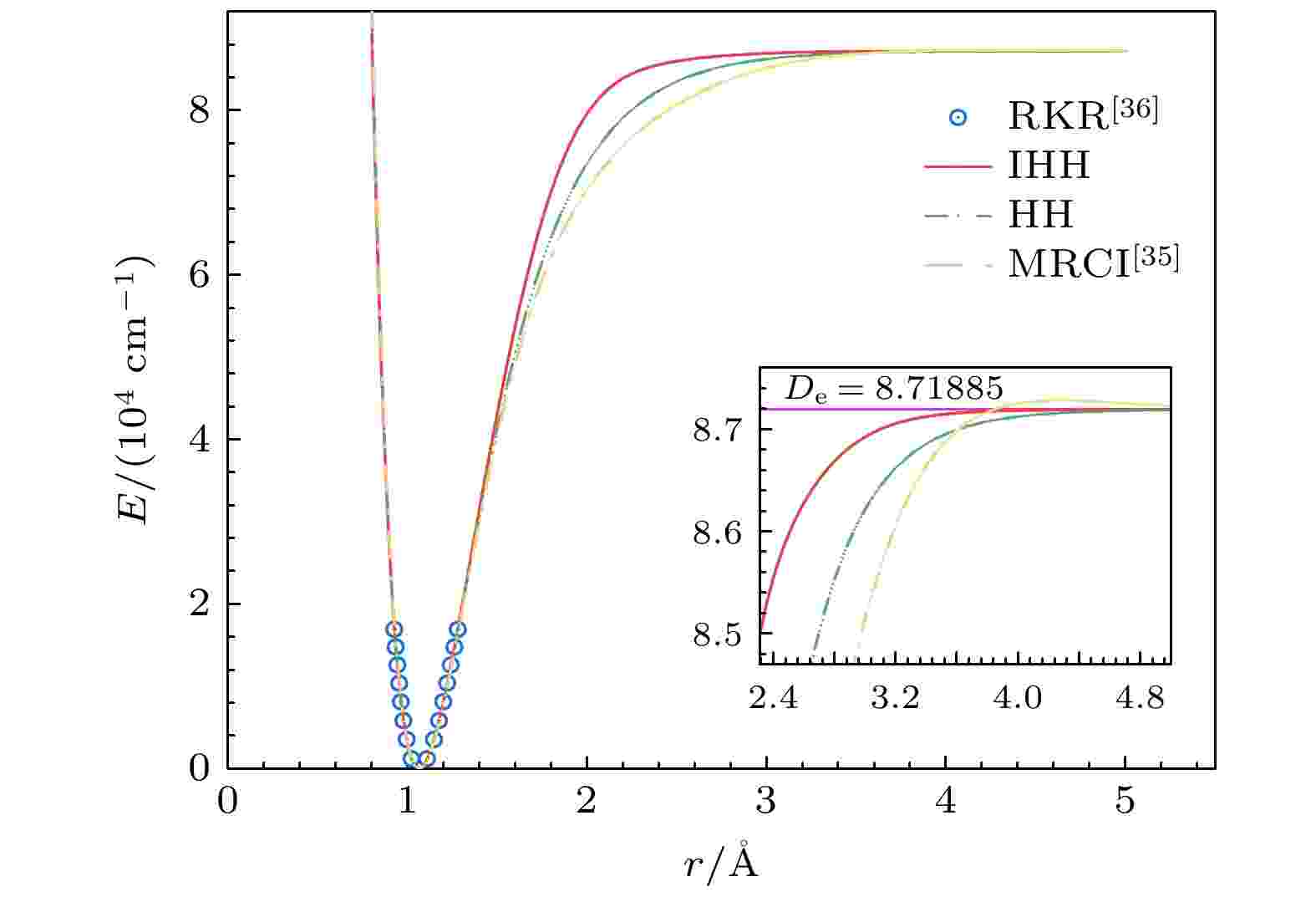
2023, 72 (16): 165101.
doi:10.7498/aps.72.20230541
Abstract +
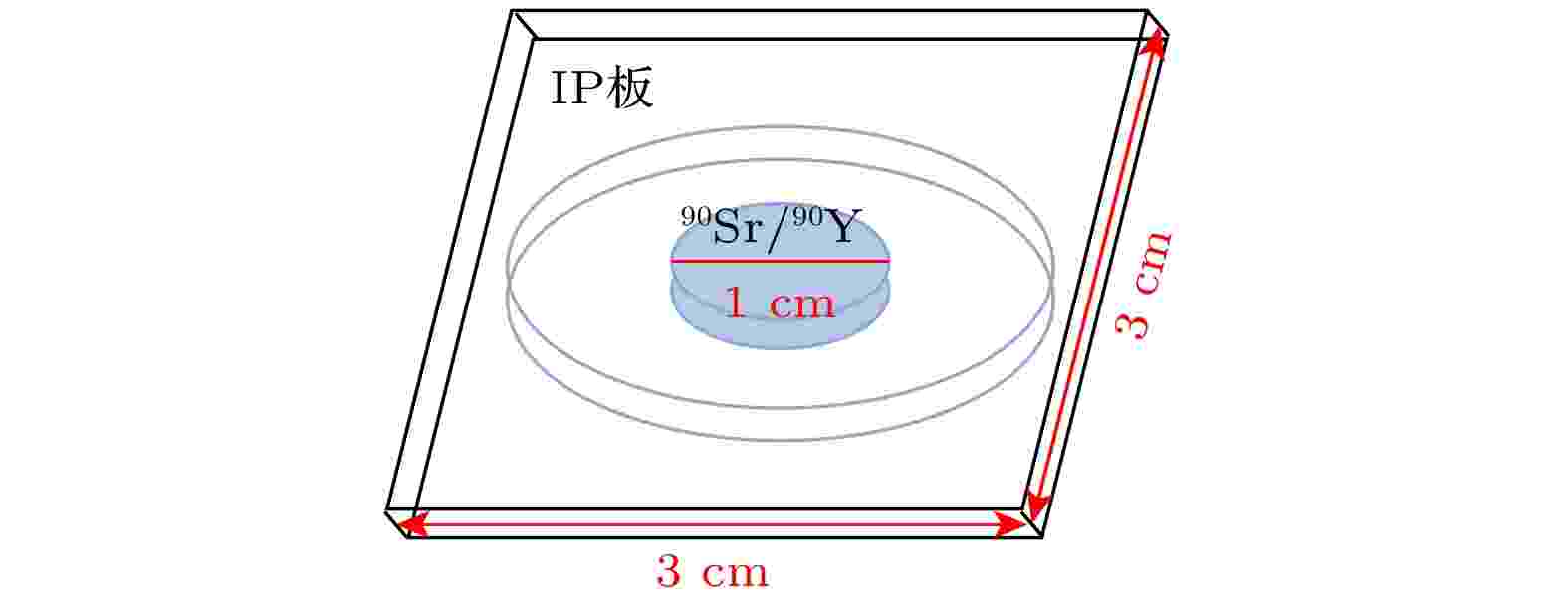
2023, 72 (16): 165201.
doi:10.7498/aps.72.20230587
Abstract +
The imaging plate (IP) is a reusable detector for detecting radiation particles in a complex electromagnetic field environment, and it is widely used as a detection medium in laser-accelerated particle beam diagnostic equipment. Therefore, it is necessary to study the performance characteristics and physical mechanism of IP. An electron source with known activity is used to explore the performance characteristics of IP. A90Sr/90Y electron source is used to measure the time attenuation curve, calibrate the absolute sensitivity, and study the law of multiple scanning of BAS-SR and BAS-TR. In the case of a longer irradiation, the fading cannot be neglected, and the attenuation curves are modified. The time attenuation characteristics indicate that the IP should be cooled after irradiation, and the scanning should be carried out in the slow decay process to reduce the influence of the reading error in the decay process. The absolute sensitivity of BAS-SR and BAS-TR to90Sr/90Y source are (0.033±0.002) PSL/eand (0.018±0.0038) PSL/e(photostimulated light, PSL), respectively, which are consistent with the results of most absolute sensitivity. The absolute sensitivity is closely related to the type of IP, scanning equipment, and experimental environment. In addition, the energy spectrum integral effect of the broad spectrumβsource has a significant influence on the absolute sensitivity. This method is only suitable for the rough evaluation of the sensitivity characteristic parameters of the IP. Multiple scanning approximately satisfies the double exponential function distribution, which is consistent with the physical model. The characteristics of IP are determined by its storage principle. The fluorescence layer of IP is composed of typical electron trapping materialsMFX(M= Ca, Sr, Ba;X= C1, Br, I) alkaline earth metal fluorhalide BaFBr. When the IP is irradiated, a large number of free electron-hole pairs are excited by the deposited energy in the material, and the free electrons will be captured by the electron trap, so the fluorescence layer of the IP records the radiation particles’ information through the energy deposited. In this paper, we study three kinds of models. Based on the models, a photo-stimulated luminescence model is proposed to describe the electron transfer process. The photo-stimulated luminescence model describes the physical mechanism of energy deposition, information storage, and information scanning of radiation particles. The relationship between the physical mechanism and characteristics is explained effectively by combining the microscopic mathematical model with the macroscopic physical phenomenon. It provides a specific data basis for the subsequent application of IPs in laser plasma diagnostic experiments.
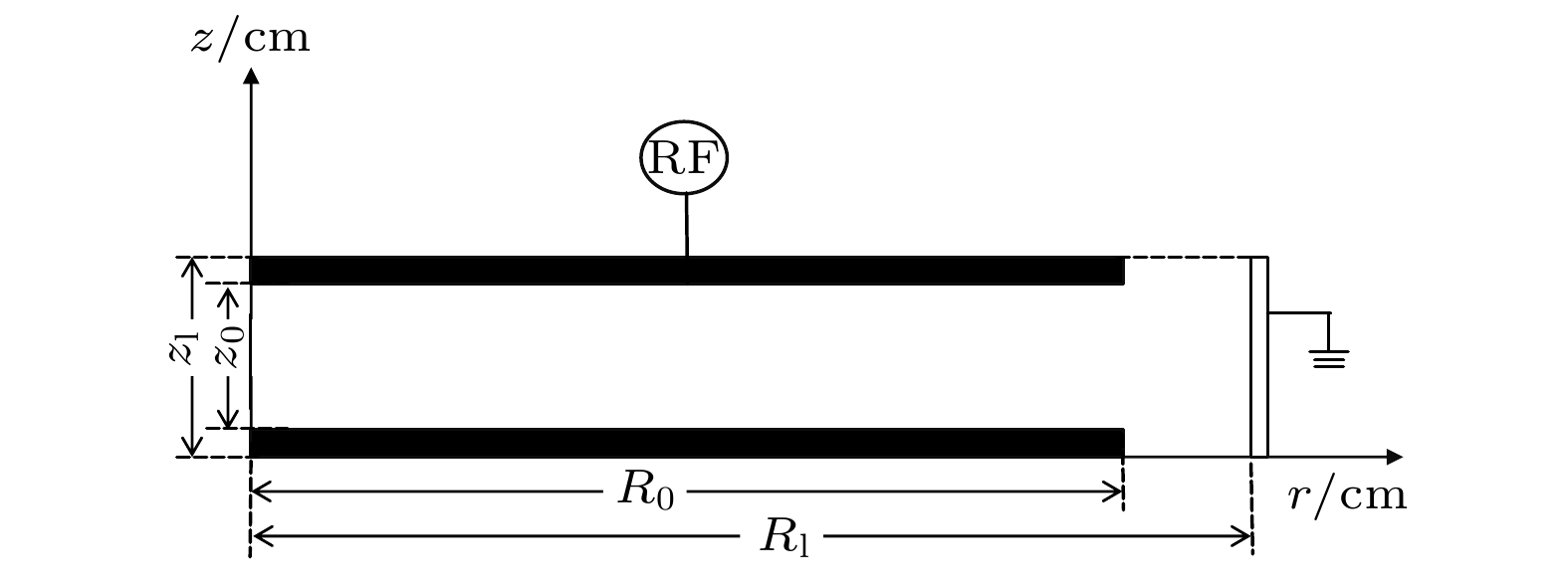
EDITOR'S SUGGESTION
2023, 72 (16): 165202.
doi:10.7498/aps.72.20230686
Abstract +
In this work, we develop a two-dimensional fluid model to study the spatial density distributions of dust particles in a radio frequency capacitively coupled silane plasma. Unlike those scenarios based on the one-dimensional fluid model, in this work, the nonuniformity of the radial density distributions of dust particles is attributed mainly to the radial components of the electric field force and the ion drag force acting on the dust particles, leading to the two local density peaks near the electrode edges. It seems that dust particles tend to overcome the support of the electric field force and move much closer to the electrodes, as one of the density peaks indicates. Moreover, with the decrease of the radii of the discharge electrodes or the distance between them, the radial component of the ion drag force is enhanced, resulting in more dust particles gathering near the electrode edge region, and forming a ring-shaped particle density distribution. In the case of the discharge electrodes wrapped with dielectric materials, the uniformity of the radial density distributions of dust particles between the two electrodes is improved. Finally, the vortex motion of a single dust particle near the electrode edge region is also simulated in this work.
CONDENSED MATTER: STRUCTURAL, MECHANICAL, AND THERMAL PROPERTIES
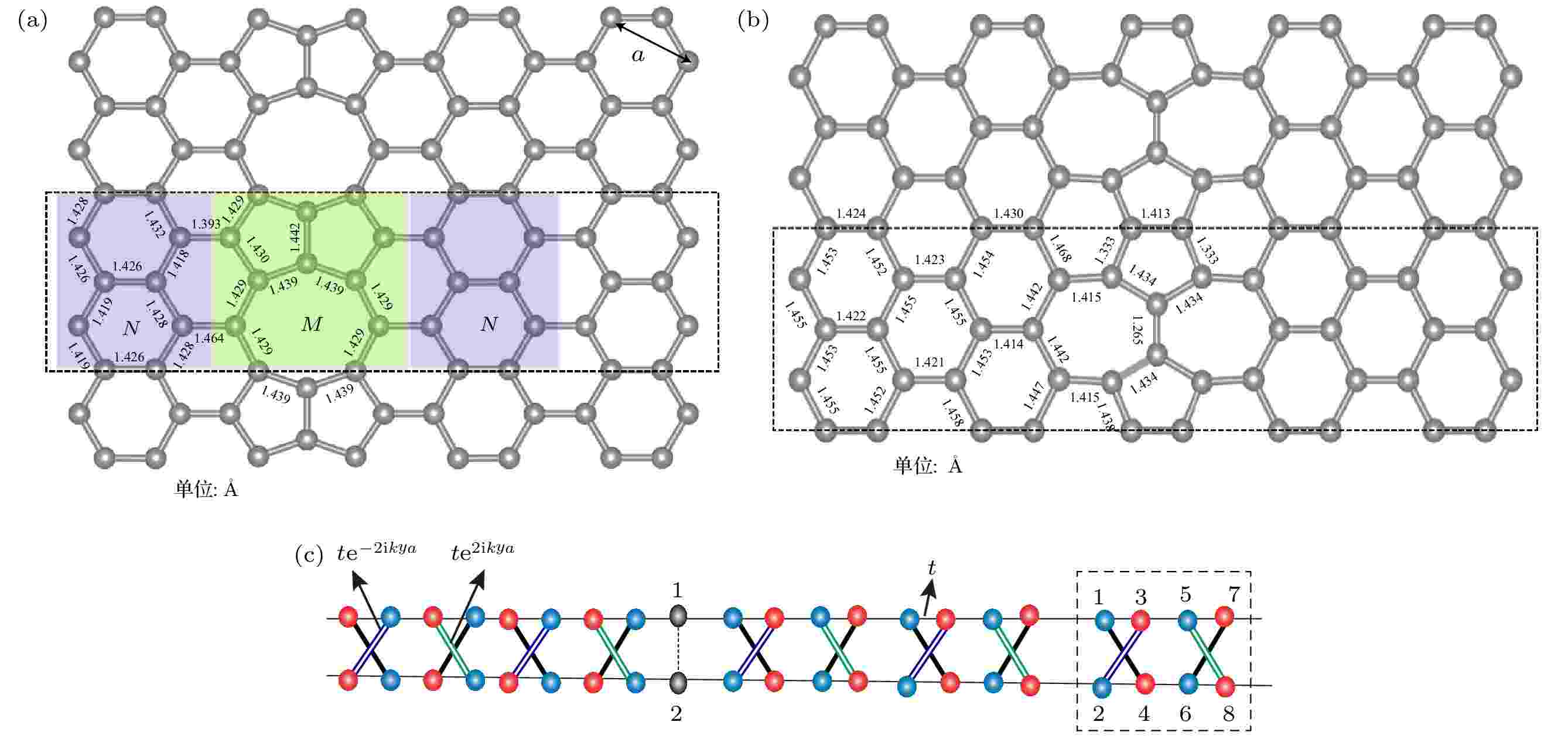
2023, 72 (16): 166101.
doi:10.7498/aps.72.20230736
Abstract +
The line defect of graphene has significant applications in valleytronics, which has received extensive attention in recent years. It is found experimentally that there exists local deformation around the line defect. Current studies generally believe that the influence of local deformation on the valley transport properties can be negligible, because the modifications to the nearest neighbour hopping energy is less than 5% under the small deformation. Based on the first-principles calculations and the non-equilibrium Green’s function method, we investigated the effect of local deformation on the valley transport properties of two different kinds of line defects, the 58 ring line defect and the 57 ring line defect. It is found that for the 58 ring line defect, the effect of local deformation on the valley transmission coefficient is not evident at lower energies. However, at higher energies, the impact of local deformation is obvious, and the maximum valley transmission coefficient does not decrease with increasing energy, but can be maintained 1 within a large energy range. In contrast, the influence of local deformation on the valley transmission coefficient of the 57 ring line defect indeed can be negligible, regardless of the level of energy. Further investigation indicates that the change of the C—C bond length connected to the two defect atoms in the 58 ring plays a key role in the transmission of the valley states across the line defect. If this part of the influence is not taken into account, the valley transmission coefficient is nearly unaffected by the local deformation. The valley state enters the right side of the line defect directly through the bond connected to the line defect, so the change in bond length connected to the line defect has a significant impact on the valley transmission. This special structure does not exist in the 57 ring, where the valley states will have to pass through a narrow region containing 57 ring to enter the right side of the line defect, resulting in different valley scattering phenomena. By constructing two parallel line defects, the 100% valley polarization can be achieved in a large angular range with the 58 ring line defect. The finding has important implications for the design of graphene line defect based valley filters.
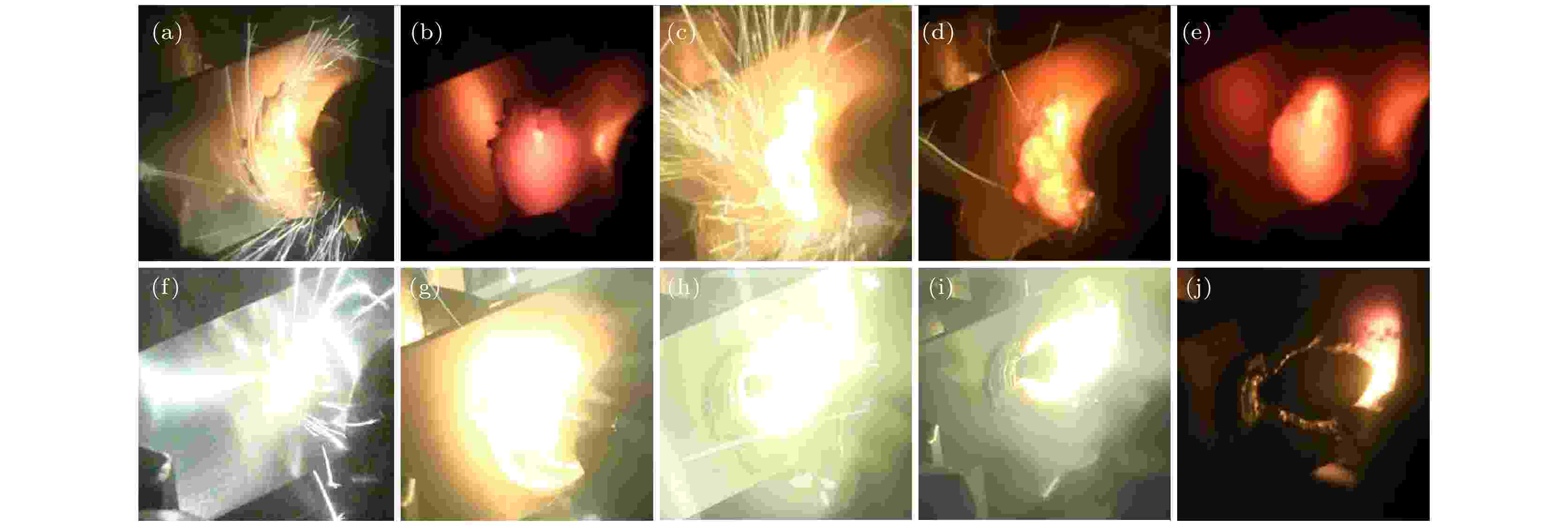
EDITOR'S SUGGESTION
2023, 72 (16): 166102.
doi:10.7498/aps.72.20230396
Abstract +
Oxides formed in the combustion process significantly affect the flame retardancy of titanium alloys, however, the evolution mechanism and formation mechanism of the combustion products of 600 ℃ high temperature titanium alloy remain uncertain. Frictional ignition method is employed in this paper to study the combustion behaviors of 600 ℃ high temperature titanium alloy, and the flame retardancy is evaluated according to the friction time, oxygen content and combustion state.In-situobservation of the burning phenomenon at the friction position and morphology after combustion is investigated, and the combustion states can be divided into oxidation stage, ignition stage and extended combustion stage. Further microstructure analysis is conducted subsequently by focus ion beam (FIB) and high resolution transmission electron microscope (HRTEM) to characterize the oxidation products with different valences in different zones of combustion microstructure. Al2O3, Ti2O3and TiO2are observed as the main combustion products in the heat-affected zone, melting zone and combustion zone, respectively. Notably, TiO2is found to be formed by Ti2O3under the combustion condition, which is different from the TiO2transformed from the TiO mesophase under oxidation condition. This results in a lax structure composed of spherical Ti2O3particles and porous Ti matrix in the melting zone. Thermodynamic calculations including Gibbs free energy and decomposition pressure are discussed to explain the evolution mechanisms and formation mechanisms of different oxides. It is revealed that an Al content of 6% is insufficient to form a continuous protective Al2O3layer at the interface of the melting zone and heat affected zone. The difference in reaction path between TiO2formed by TiO and by Ti2O3can be ascribed to the formation of gaseous TiO phase. The sharp increase of TiO vapor pressure at about 1800 K reduces the stability of titanium oxide, thus causing the as-formed TiO to evaporate rapidly and forcing titanium to transform into TiO2via a more stable phase, Ti2O3. The formation of the porous structure composed of Ti2O3and Ti at the melting zone provides a path for the rapid internal diffusion of oxygen, which severely deteriorates the oxygen prevention capability of as-formed oxide layers. Besides, the TiO2synthesized from Ti-O melt in the combustion zone can hardly protect the inner structure. Therefore, the flame retardancy of 600 ℃ high-temperature titanium alloy is far from satisfactory.
CONDENSED MATTER: ELECTRONIC STRUCTURE, ELECTRICAL, MAGNETIC, AND OPTICAL PROPERTIES
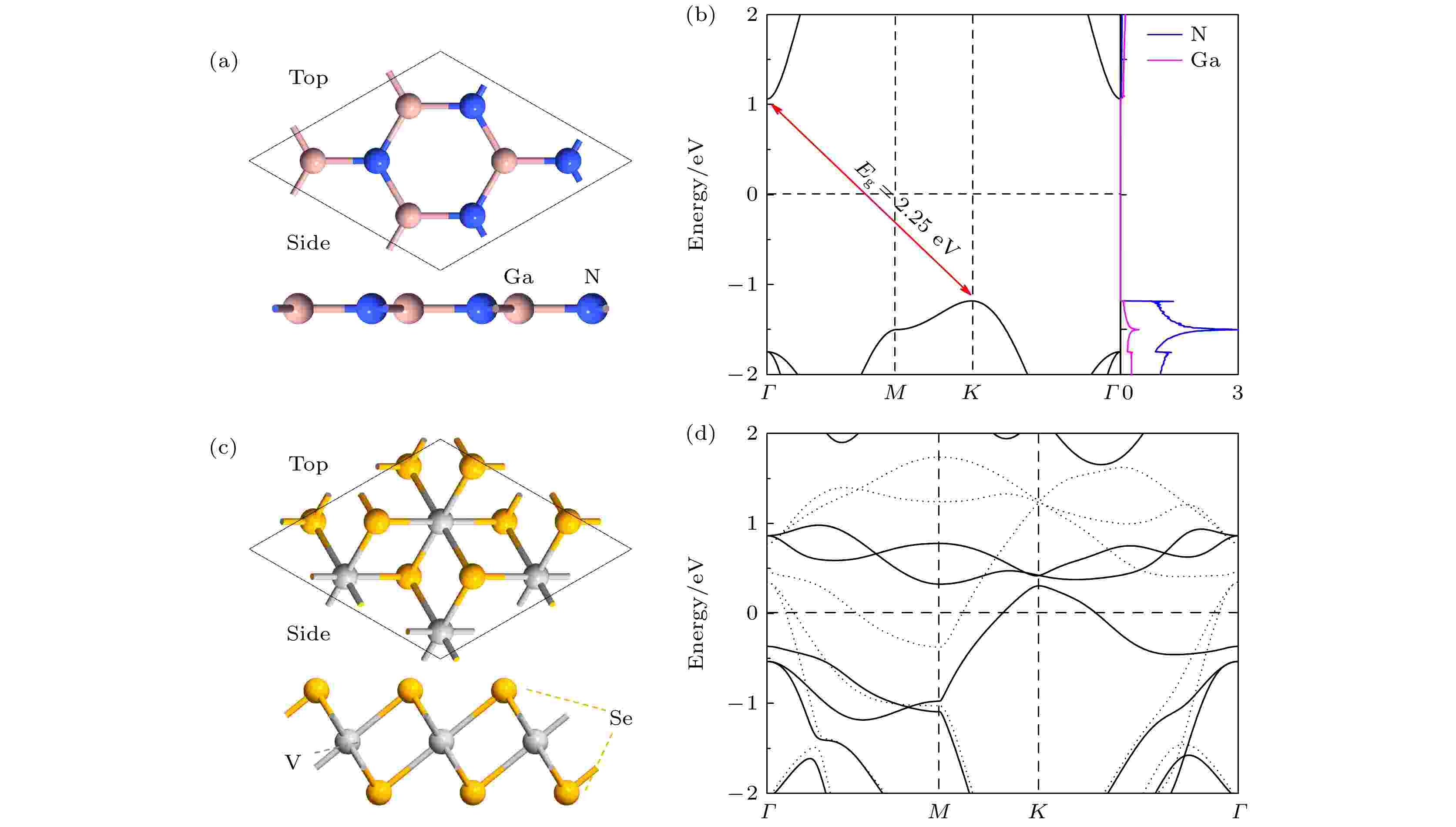
2023, 72 (16): 167101.
doi:10.7498/aps.72.20230191
Abstract +
Reducing the Schottky barrier at the metal-semiconductor interface and achieving Ohmic contacts are very important for developing high-performance Schottky field-effect devices. Based on the fact that GaN and 1T-VSe2monolayers have been successfully prepared experimentally, we theoretically construct a GaN/1T-VSe2heterojunction model and investigate its stability, Schottky barrier property and its modulation effects by using first-principle method. The calculated formation energy and the molecular dynamics simulations show that the constructed heterojunction is very stable, meaning that it can be realized experimentally. The intrinsic heterojunction holds a p-type Schottky contact and always keeps the same p-type Schottky contact when tensile or compressive strain is applied. But when the external electric field is applied, the situation is different. For example, a higher forward electric field can cause the heterojunction to change from a Schottky contact into an Ohmic contact, and a higher reverse electric field can lead to a variation from a p-type Schottky contact to an n-type Schottky contact. In particular, by implementing chemical doping, the transition from Schottky contact to Ohmic contact can be achieved more easily for the heterojunction. For example, the introduction of B atom enables the GaN/1T-VSe2heterojunction to realize a typical Ohmic contact, while for C and F atom doping, the GaN/1T-VSe2heterojunction can achieve a quasi-Ohmic contact. These studies provide a theoretical reference for the practical application of the suggested heterojunction, and are of very important in designing novel high-performance nano-scale electronic devices.
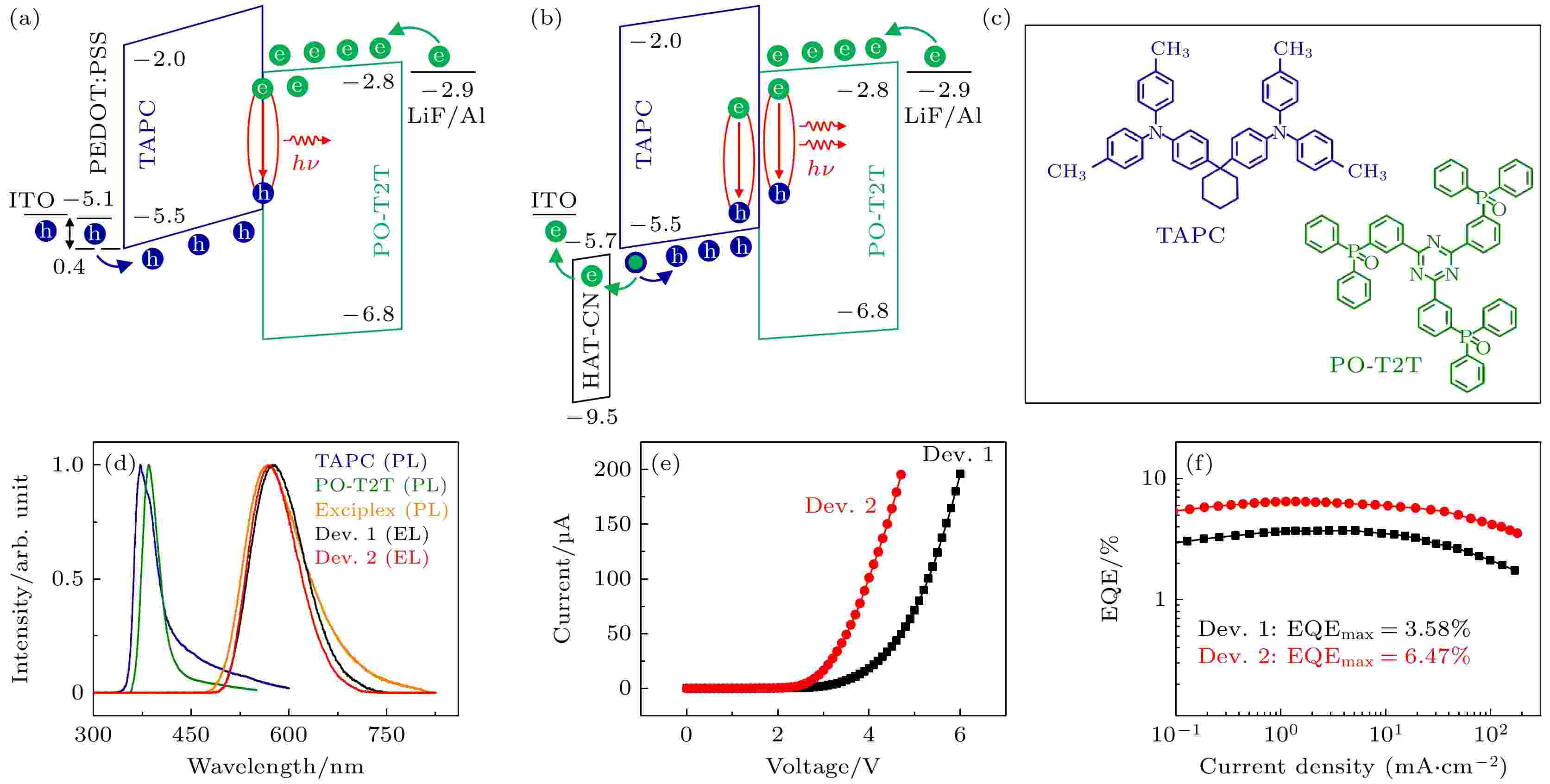
2023, 72 (16): 167201.
doi:10.7498/aps.72.20230765
Abstract +
Intersystem crossing (ISC) and reverse ISC (RISC) between singlet and triplet polaron-pair and exciplex state are important spin-mixing processes in exciplex-based organic light-emitting diodes (EB-OLEDs). These two processes usually show normal current dependence which weakens with the increase of bias-current. This is because the bias-current increases by improving the device bias-voltage. When the bias-voltage rises, the electric field within the device is enhanced, which facilitates the electric-field-induced dissociation of polaron-pair and exciplex states and then reduces their lifetime. That is, less polaron-pair and exciplex states participate in the ISC process and RISC process, leading these two processes to weaken. Here, magneto-electroluminescence (MEL) is used as a fingerprint probing tool to observe various current-dependent ISC and RISC processes in EB-OLEDs with different charge balances via modifying the device hole-injection layer. Interestingly, current-dependent MEL traces of the unbalanced device display a conversion from normal ISC (1–25 μA) process to abnormal ISC (25–200 μA) process, whereas those of the balanced device show conversions from normal ISC (1–5 μA) into abnormal RISC (10–50 μA) and then into normal RISC (50–150 μA) and finally into abnormal ISC (200–300 μA) process. By fitting and decomposing the current-dependent MEL traces of the unbalanced and balanced devices, we find that the ISC process and RISC process in these two devices first increase then decrease as the bias-current increases. These non-monotonic current-dependent ISC process and RISC process are attributed to the competition between the increased number and the reduced lifetime of polaron-pair state and exciplex state during improving the bias-current. Furthermore, the RISC process in the balanced device is stronger than that in the unbalanced device. This is because the balanced carrier injection can facilitate the formation of triplet exciplex states and weaken the triplet-charge annihilation (TQA) process between triplet exciplex states and excessive charge carriers, which leads the number of triplet exciplex states to increase. That is to say, more triplet exciplex states can be converted into singlet exciplex states through the RISC process, causing the external quantum efficiency of the balanced device to be higher than that of the unbalanced device. Obviously, this work not only deepens the understandings of current-dependent ISC and RISC processes in EB-OLEDs, but also provides an insight into the device physics for designing and fabricating high-efficiency EB-OLEDs.
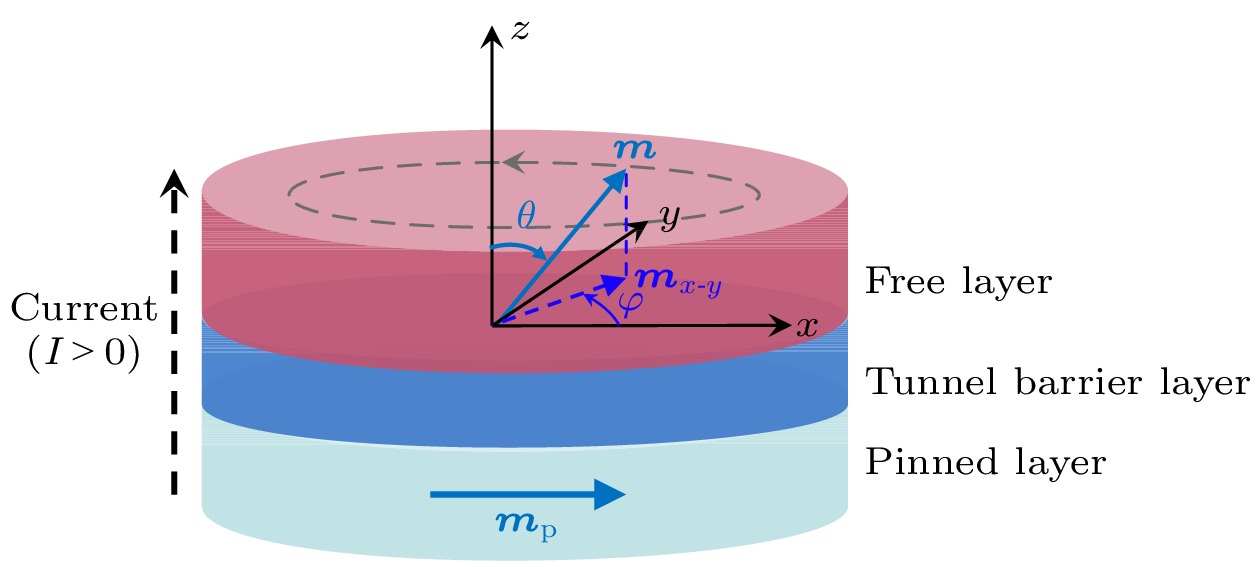
EDITOR'S SUGGESTION
2023, 72 (16): 167501.
doi:10.7498/aps.72.20230628
Abstract +
The spin-torque nano-oscillator (STNO), which is a novel type of nano-sized microwave oscillator driven by direct current, is considered as a promising candidate for future radio frequency (RF) transceivers owing to its scalability, nanoscale size and high frequency tunability. However, the potential application of STNO is limited because its stable oscillation requires an external magnetic field. In this work, the influences of the field-like torque and applied current intensity on the stable oscillation of STNO with a perpendicularly magnetized free layer are studied theoretically based on the macrospin model (also known as the single-spin or single-domain model) and the Landau-Lifshitz-Gilbert-Slonczewski (LLGS) equation in the absence of magnetic field. It is demonstrated numerically that a stable oscillation of STNO can be observed when the ratio between the field-like torque and the spin torque is a negative value and larger than a certain value that depends on the damping coefficient and the current intensity, whose physical mechanism can be understood by the energy balance equation. Moreover, the frequency of stable oscillation of STNO can be modulated by the ratio between the field-like torque and the spin torque and also by the current intensity. Particularly, the larger the absolute value of the ratio between the field-like torque and the spin torque and the smaller the applied current intensity (above the critical current intensity), the more conducive it is to suppressing the formation of second and third oscillation frequencies, thereby enhancing the STNO’s “single-frequency” feature. Our findings provide a theoretical scheme for realizing a frequency tunable zero-field STNO, which may be useful for designing future RF transceivers.
INTERDISCIPLINARY PHYSICS AND RELATED AREAS OF SCIENCE AND TECHNOLOGY

2023, 72 (16): 168101.
doi:10.7498/aps.72.20230636
Abstract +
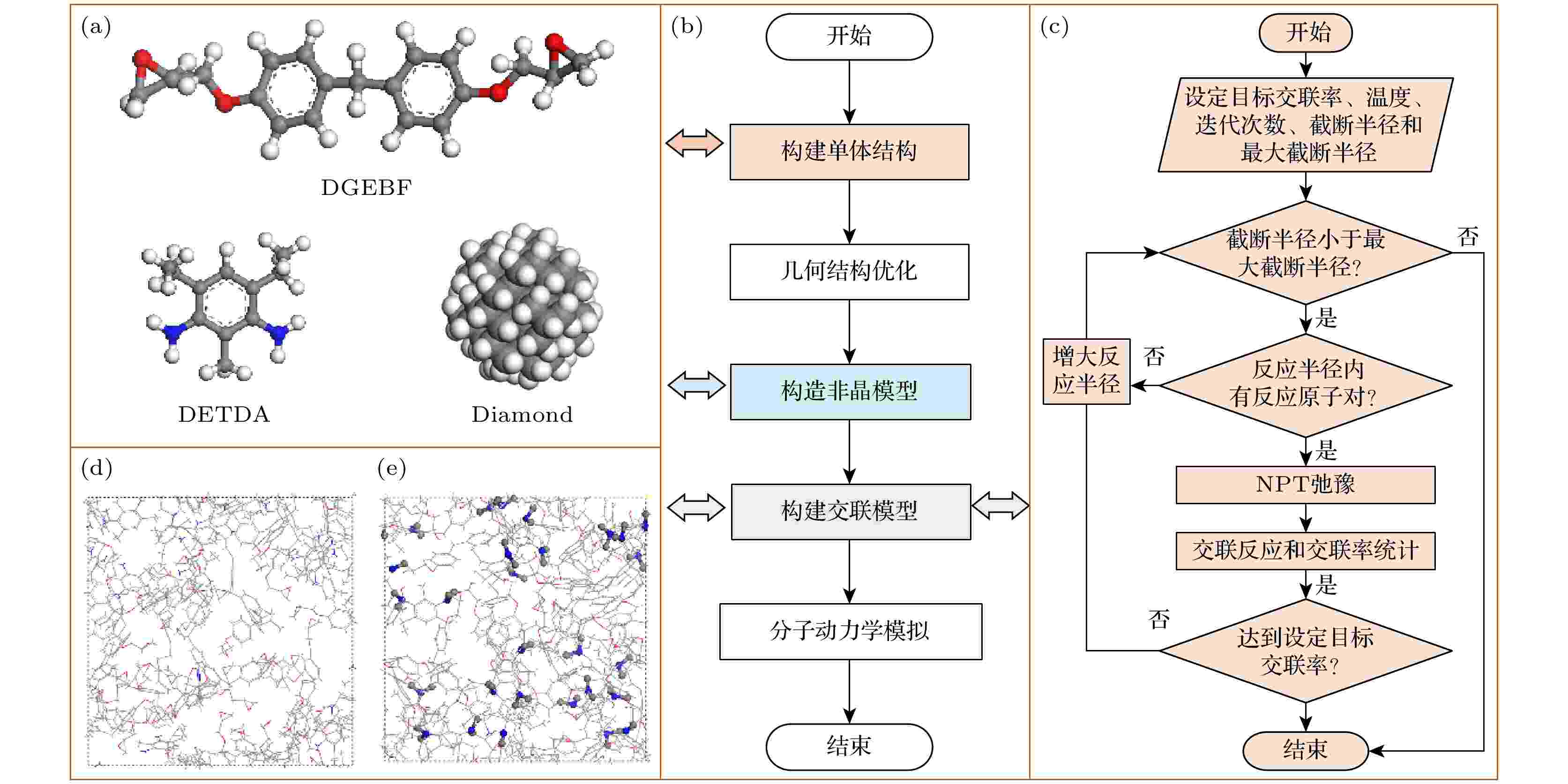
2023, 72 (16): 168102.
doi:10.7498/aps.72.20222270
Abstract +
Improving the thermal conductivity (TC) of epoxy resin thermal interface material is of great significance in tackling the heat dissipation problem of high heat flux in microelectronic chips such as 5G. Using non-equilibrium molecular dynamics (MD) method, the effects of two different filling styles of nano-diamond fillers on the TC of EP based composites are investigated. The results show that the TC of the composite increases with the diamond size when single-particle filling is used, and that a larger diamond size leads to a more significant reduction of the free volume fraction and thus an improvement of the TC. In the multi-particle packing, the composite TC first increases and then decreases with increasing particle number. Increasing the number of particles reduces the free volume fraction, but also results in a larger specific surface area and interfacial thermal resistance, which has a more significant weakening effect on the TC. Moreover, within the same mass fraction of nano-diamond filler, increasing the filler size has a more significant TC improvement on the composite than increasing the number of particles. This study is instructive for the design and preparation of high thermal conductivity nanodiamond/epoxy resin composites.
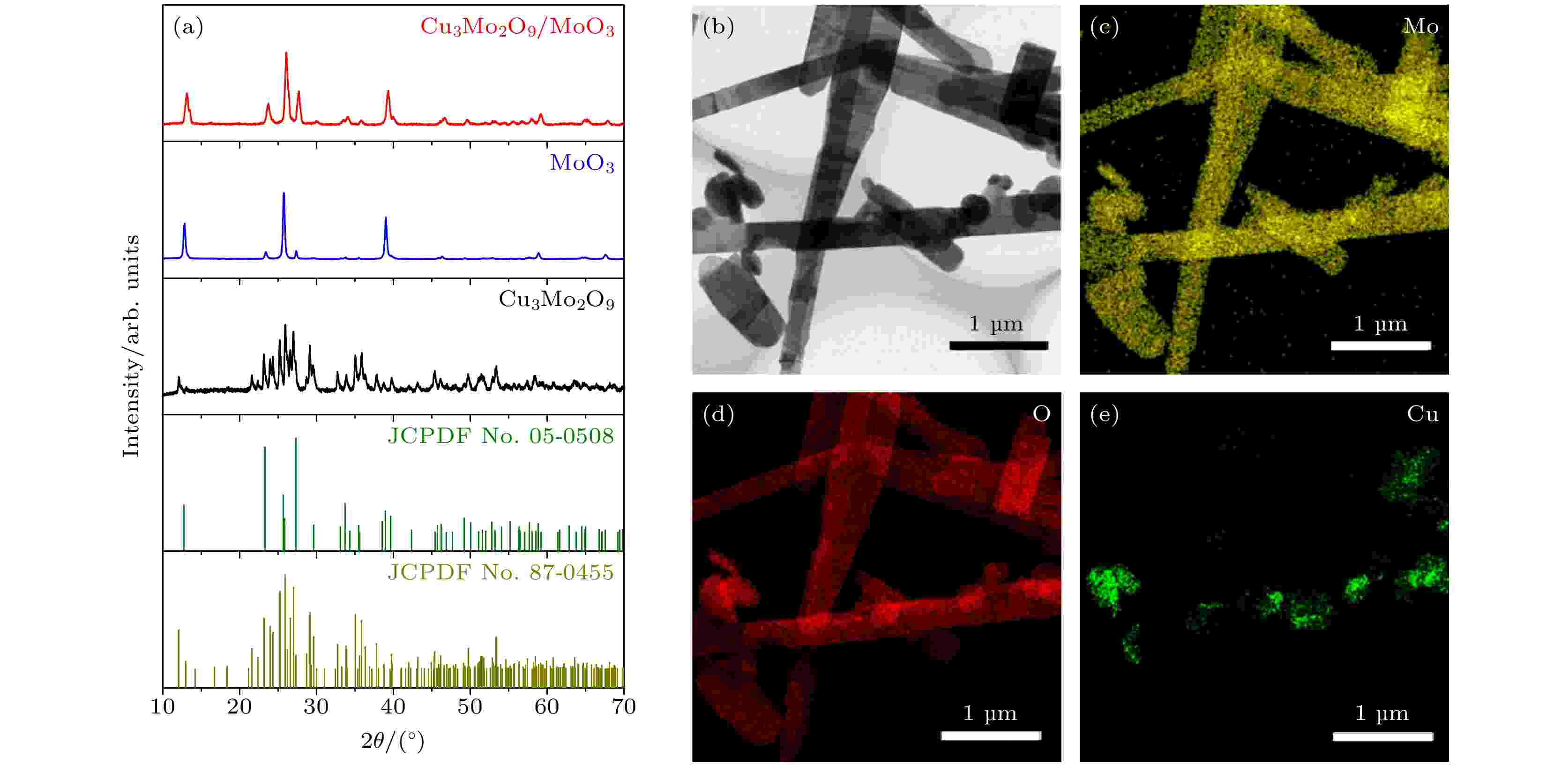
2023, 72 (16): 168103.
doi:10.7498/aps.72.20230720
Abstract +
Aquatic products contain an incredibly high nutritional value for the human body and gradually become indispensable ingredients on the Chinese table. Trimethylamine (TMA) from the deterioration of aquatic products can serve as an indicator to measure fish freshness. It is a challenge to develop an instant, fast, convenient, and efficient gas sensor for fish freshness. In this study, a novel Cu3Mo2O9/MoO3composite gas sensing material is prepared by introducing Cu3Mo2O9nanoparticles on the surface of MoO3nanobelts. The results of SEM and TEM images show that the Cu3Mo2O9nanoparticles are uniformly dispersed. Then, the TMA sensing performance of a resistance-type gas sensor based the prepared Cu3Mo2O9/MoO3composite is tested at optimal operating temperature (240 °C). the results show that the sensor possesses good response (13.9) at low concentration (5×10–6), with excellent low detection limit (2×10–7). The response time is also significantly shortened. The high sensing performance of Cu3Mo2O9/MoO3composite is attributed to the heterojunction interface, which promotes the separation of electrons from holes through its strong oxygen adsorption and catalytic effect. This significantly improves the electron transport properties and gas sensing characteristics of the composite material. Electrons flow from MoO3nanoribbons to Cu3Mo2O9, and the Fermi level reaches equilibrium. This process results in the formation of an electron loss layer underneath MoO3, and the charge transfer channel narrows, which is consistent with previous result. When trimethylamine dissociates on the nanoribbons to release electrons, the balance of the fermi lever is disrupted, and electrons flow from MoO3to Cu3Mo2O9. As a result, the charge transfer channel becomes thinner, resulting in resistance modulation and increased sensitivity. In addition, the enhancement of trimethylamine sensing performance of Cu3Mo2O9/MoO3nanocomposite can be explained by the enhancement of gas adsorption and diffusion: MoO3nanoribbons as a skeleton can effectively disperse Cu3Mo2O9particles and increase the adsorption capacity of gas molecules. And the enhanced response of Cu3Mo2O9/MoO3may be due to the good catalytic effect of Cu3Mo2O9, which is conducive to oxygen adsorption. This work provides a new strategy for preparing high-performance MoO3-based gas sensing materials.
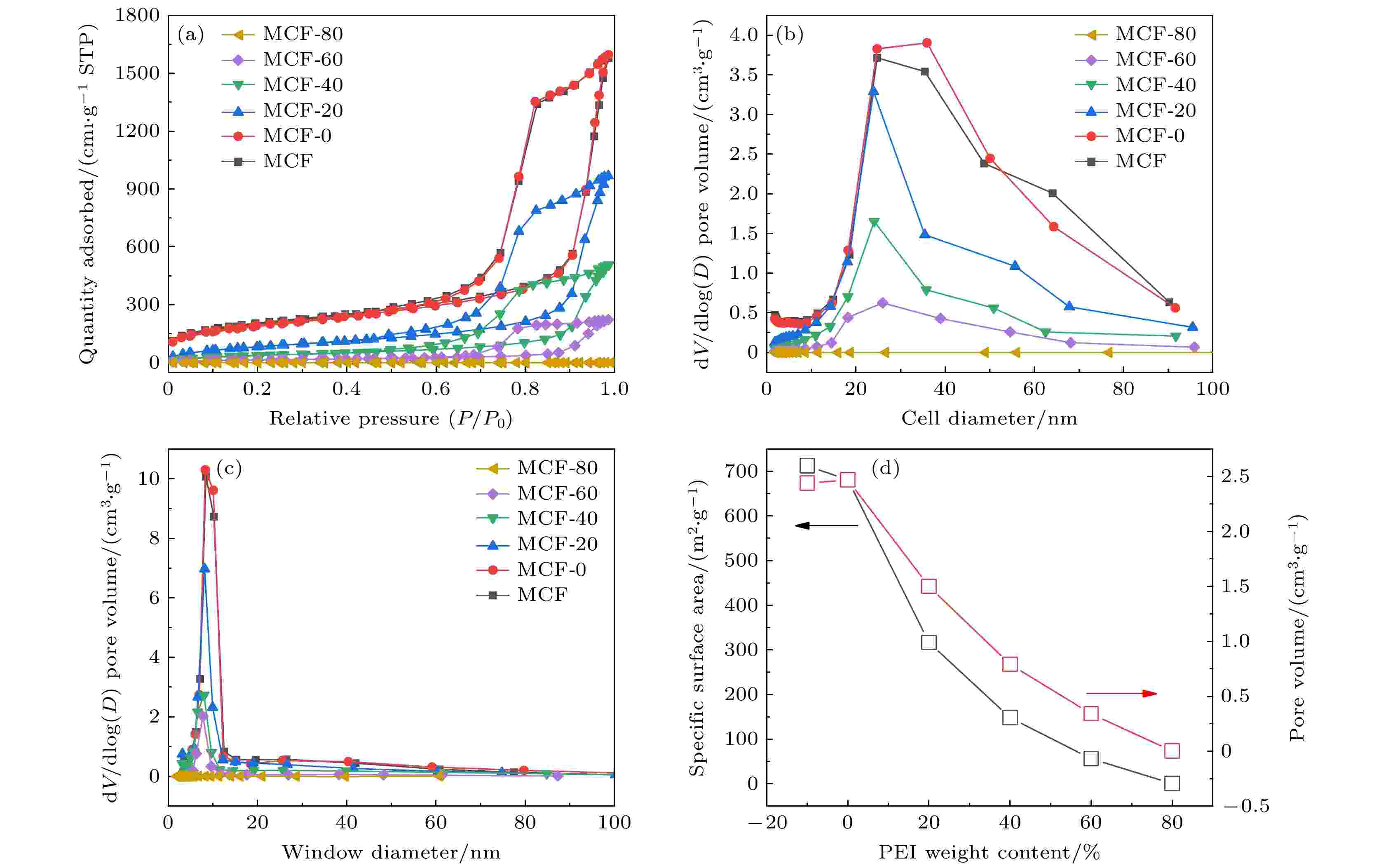
2023, 72 (16): 168104.
doi:10.7498/aps.72.20230675
Abstract +
A novel mesoporous silica foam (MCF) with a specific surface area of 712.5 m2/g and a pore volume of 2.44 cm3/g is synthesized by using triblock copolymer poly (ethylene oxide, polypropylene oxide and ethylene oxide, P123) as template and TEOS (C8H20O4Si) as silicon source. The effect of polyethylenimide (PEI) modified MCF on nanoscale pore structure is studied by positron annihilation lifetime spectroscopy (PALS) and conventional characterization methods, such as N2adsorption desorption, transmission electron microscopy, thermogravimetric analysis and Fourier transform infrared spectroscopy. The results show that the synthesized MCF has an obvious disordered mesoporous structure, and a continuous porous network with window connection between the pores is formed. Meanwhile, it can be seen directly that PEI is successfully introduced into MCF pore channels. In order to evaluate the pore size and its distribution more comprehensively, the mechanism of positron annihilation which is highly sensitive to nanometer scale open volumes in PEI loaded MCF is studied. It is found that there are two long life componentsτ3andτ4, indicating the micropores and mesopores co-existing in the sample. Furthermore, the introduction of PEI molecules results in a significant decrease inτ3andτ4, and the lifetime values are then corrected by using the positron annihilation rate formula in pure gas to calculate the pore size. The results show that the pore size gradually decreases with the filling of the organic molecule PEI. This provides a new insight into the mechanism of regulating the pore structure of MCF by polyethyleneimine modification, as well as the characterization of pore structure in organic-modified mesoporous molecular sieves.

2023, 72 (16): 168105.
doi:10.7498/aps.72.20230064
Abstract +
In the process of production or long-time use of a thin metal plate, micro defects (micro particles or pores) will be produced in its interior. The number and size of these micro defects determine the quality of the thin metal plate, affecting its service life and factor of safety. Therefore, quantitative and accurate characterization of micro defects is a necessary to ensure the quality and safety of thin metal plate products. In this work, we study the application of motion induced eddy current magnetic field testing in electromagnetic testing to detect defects in conductive material and nonmagnetic material. The simulation results show that when the lift-ff distance and the surface remanence of the permanent magnet are determined, the size of the permanent magnet is positively correlated with the amplitude of the defect detection signal. The main reason is that in a motion induced electric field without defects, the amplitude of defect detection signal is linearly related to the current density mode at each point on the defect motion path. Increasing the size of the permanent magnet can effectively improve the current density mode. As a continuation of the above results, an optimization method for excitation magnetic field in motion induced eddy current magnetic field detection is proposed. The two types of permanent magnet arrays generated by this method generate larger amplitude defect detection signals than that by simple permanent magnets with the same volume and surface residual magnetism. The experimental results show that the excitation magnetic field arrangement designed by the above optimization method increases the signal amplitude by 80%–90% compared with that by traditional method. This optimization method conduces to improving the sensitivity of motion induced eddy current magnetic field detection methods.
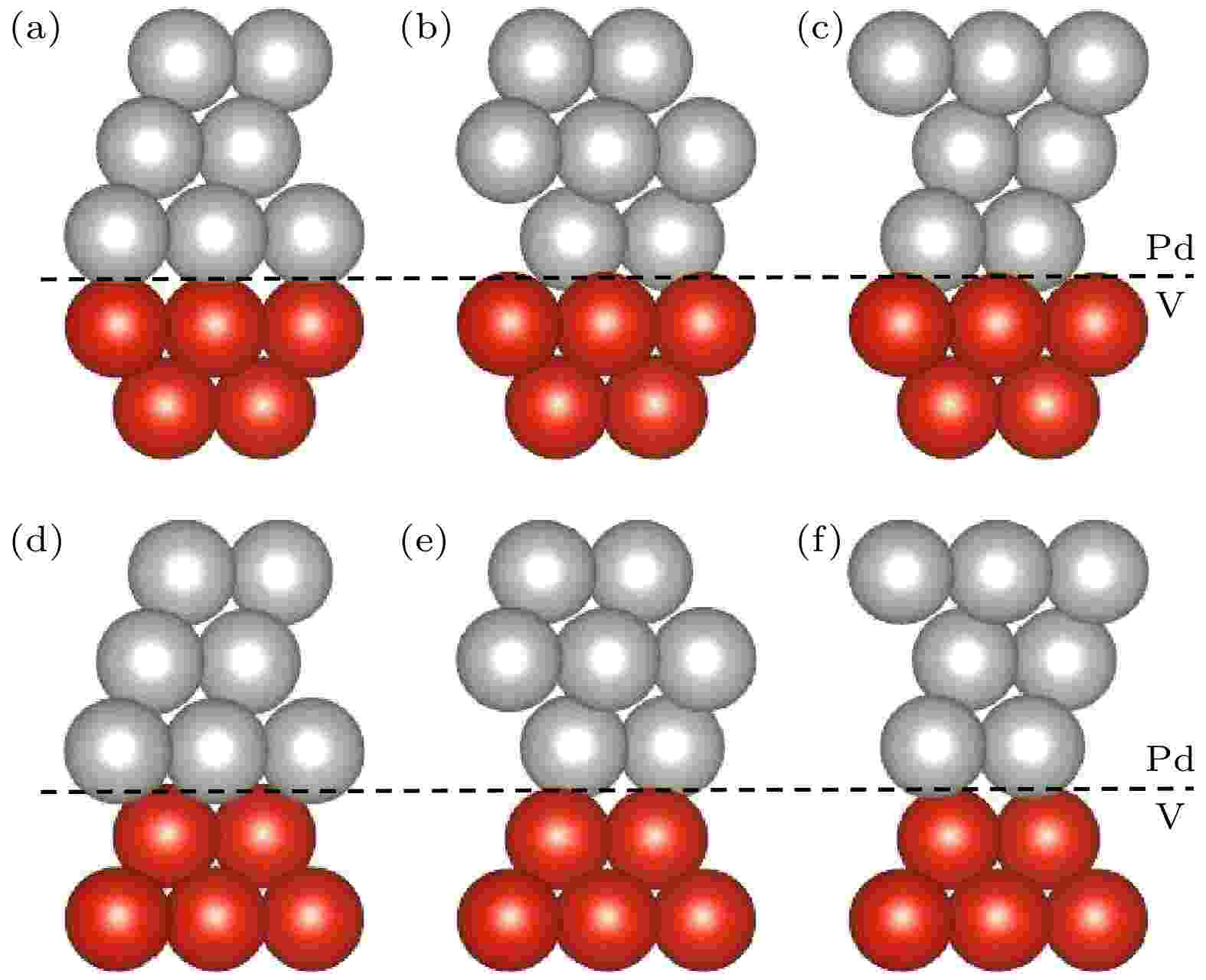
2023, 72 (16): 168801.
doi:10.7498/aps.72.20230132
Abstract +
Hydrogen permeation through vanadium/palladium (V/Pd) metal composite membranes is an effective and practical method of separating hydrogen from gas mixtures. In order to gain an insight into the relation between the interfacial structure and hydrogen adsorption/diffusion properties of the catalytic Pd layer bonded to the metal membrane, and then improve the ability of the alloy membrane to purify hydrogen, the first principle based on the density functional theory is used to study the hydrogen adsorption/diffusion behavior at the V/Pd metal composite membrane interface. The results show that because the charge density at the V/Pd interface increases with the V/Pd bonding increasing, the dissolution energy of hydrogen atom (H) increases with it approaching to the interface, and it has the highest dissolution energy near the V/Pd interface (0.567 eV). Hydrogen migration energy barrier calculations show that compared with the maximum energy barrier for horizontal diffusion of H along the V/Pd interface (0.64 eV), the H vertical V/Pd interface energy barrier (0.56 eV) is small, thus H tends to migrate vertically V/Pd interface and diffuse from the Pd layer to the V substrate side. As the hydrogen solvation energy of the Pd layer at the V/Pd interface (0.238 eV) is higher than that on the V membrane side (–0.165 eV), H will gather on the V film side of the interface, which is easy to cause hydrogen to be embrittled. Calculations of Pd/Fe doping of the V matrix show that comparing with the undoped energy barrier (0.56 eV), Pd/Fe doping can significantly reduce the maximum energy barrier (0.45 eV/0.54 eV) in the diffusion path of the interface, which is favorable for hydrogen permeation and diffusion. And the doped interface can inhibit the interdiffusion of V layer and catalytic Pd layer to a certain extent, which improves the structural stability of the composite film.
GEOPHYSICS, ASTRONOMY, AND ASTROPHYSICS

2023, 72 (16): 169501.
doi:10.7498/aps.72.20230569
Abstract +
Laser self-mixing interferometry (SMI) has been widely researched and applied to the field of traditional physical quantities (such as displacement, distance, velocity and vibration) detection due to the well-known merits of compact structure, low-cost and high sensitivity, additionally, it has also shown great potential in nano-particle sizing during the last two decades, primarily depending on the incoherent stochastic superposition of laser beam’s interaction with each particle in the illuminating volume, and the particle diameter can be determined from the power spectra of self-mixed signals through Lorentz fitting. SMI particle sensing generally uses constant current driving laser diodes (LD), so the power spectrum peak occurs around zero-frequency and merely exhibits the right-hand half. Some other particle sensors using solid-state lasers (SSL), however, prefer to employ a pair of acousto-optic modulators (AOM) as frequency shifters, which pronouncedly increases the complexity and the cost of the whole system. In this paper, linear modulation current is applied to a LD to achieve laser frequency tuning and conveniently shift the concerned Lorentz peak to any desired spectrum position. Moreover, higher-order harmonics of the shifted Lorentz peak, arising from intrinsically tilted SMI fringes, exhibit wider spectrum broadening than the main peak and can be employed to improve the sensitivity in nano-particle recognition. The technique proposed has been validated by simulation and experimental results, and it is beneficial to developing low-cost, compact and highly sensitive SMI particle sensors or instruments.




























